This post may contain affiliate links. This just means I may receive a small commission at no extra cost to you for helping them promote their product or service. I don’t endorse any services I don’t personally use or recommend.
Welcome to the eighth continent.
A vast, whimsical land of leaping lemurs and bulbous baobab trees. Madagascar is one of the most ecologically unique destinations on earth. Over 90% of its flora and fauna are found ONLY on this island. The country protects this diverse wildlife with an extensive series of national parks and reserves traversing numerous ecosystems. And the best way to reach these parks? A self-drive Madagascar road trip.
While yes, this mode of transport is admittedly more adventurous than the stereotypical group tour or driver-hire that most visitors opt for, it’s also much more fun and totally doable.
This 22-day Madagascar road trip itinerary is designed with wildlife and adventure lovers in mind. It’s got a fun mix of off-road adventuring and coastal drives while hitting all the must-see attractions and best wildlife destinations in the southern half of the country. It’s the exact route we took when we visited Madagascar in May.
This blog post is just your road map for where to go in Madagascar. If you’re looking for vital information about what it’s like to actually drive in Madagascar, which SIM card works best, ATM info, how to find good hotels/campsites, and more, head on over to “Should You Self-Drive in Madagascar: What to Know Before You Hit the Road”.
Where to Rent Your 4×4: Road Trip Africa
Car rental services for 4x4s in Madagascar are few and far between. Fortunately, Road Trip Africa has several different vehicles to choose from.
For this particular 3-week itinerary, you will need to opt for the uber-powerful Nissan Navarro. This vehicle is a little more expensive than the Nissan NP300, but if you want to drive to Tsingy, this is a must—trust me.
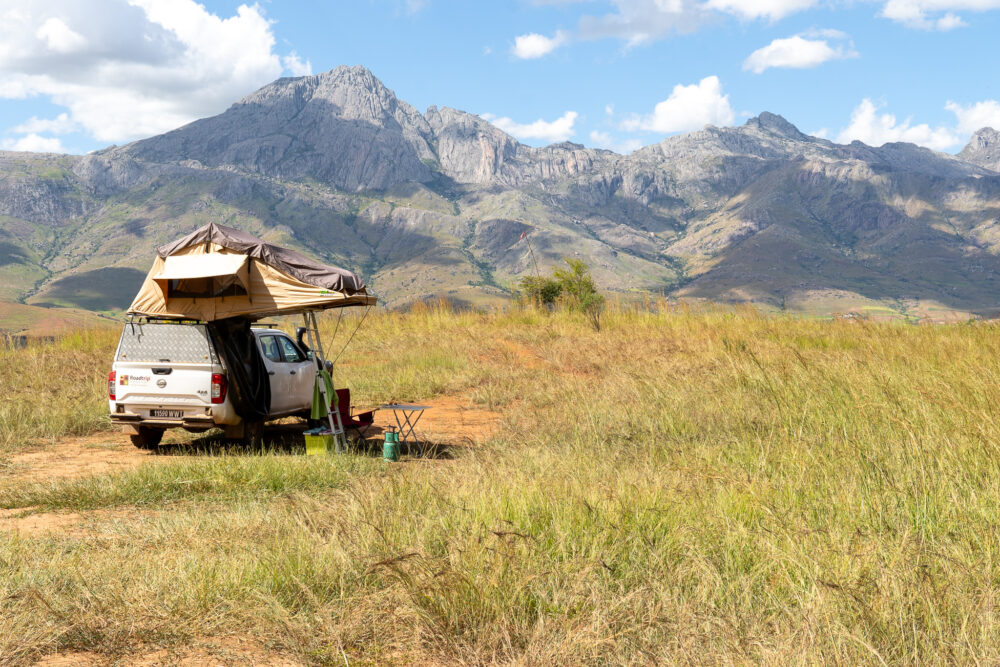
All the vehicles offered come with a ground tent, sleeping mats, sleeping bags, pillows, cooking stove, camping chairs, camp table, cooking utensils, road map, and the Bradt Madagascar Guidebook (which is essential in my opinion).
We opted for the rooftop tent addition, and if you like to camp, I highly recommend it.
Aside from the excellent vehicle, I found that Road Trip Africa had excellent customer service, and each of their cars is equipped with a tracking device so that if you get yourself into trouble, you can be rescued right away! While we didn’t encounter any problems on our Madagascar road trip, we met a Dutch couple who ripped the oil pan off their engine when they drove over a stump. RTA had them leave the car, ride with us, and sent a technician out the same day to fix their car and drive it ahead to them so they didn’t have any delay in their trip.
Looking For a More Budget-Friendly Car Rental on your Madagascar Road Trip?
Road Trip Africa offers a variety of vehicles starting at $80 per day (depending on the season).
The only problem is that you can’t drive this itinerary with the more budget-conscious vehicles. They simply can’t make it through the mud and high-clearance paths. You can, however, take ANY vehicle on my short Madagascar road trip itinerary. *******
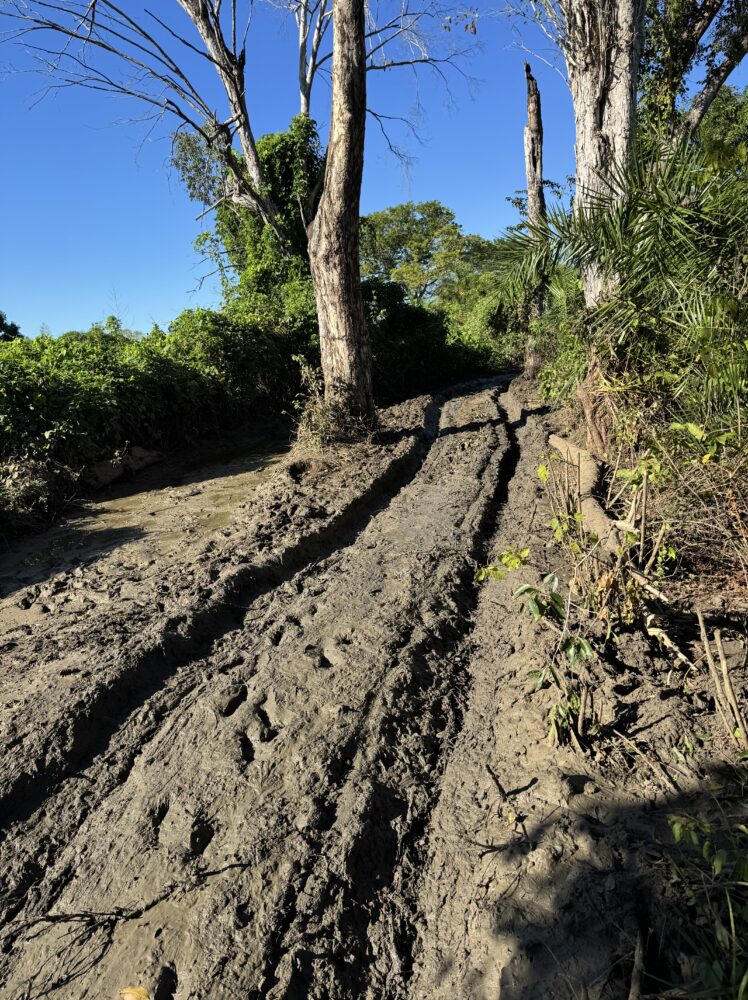

Best Time of Year For This Madagascar Road Trip Itinerary
Madagascar has a violent cyclone season that you MUST avoid. Rain can also make much of the country totally impassable. The northern region of the country is also vastly different, climate-wise, from the southern. If you’re getting ready to embark on this particular road trip, then you can rent your car anytime from late April to Early October.
In my personal opinion, May is the best month to plan your travels.
This is because the road to Tsingy is open and operational, but the June/July crowds have yet to hit the national parks. Isalo and Ranomafana National Parks suffer from overcrowding the most.
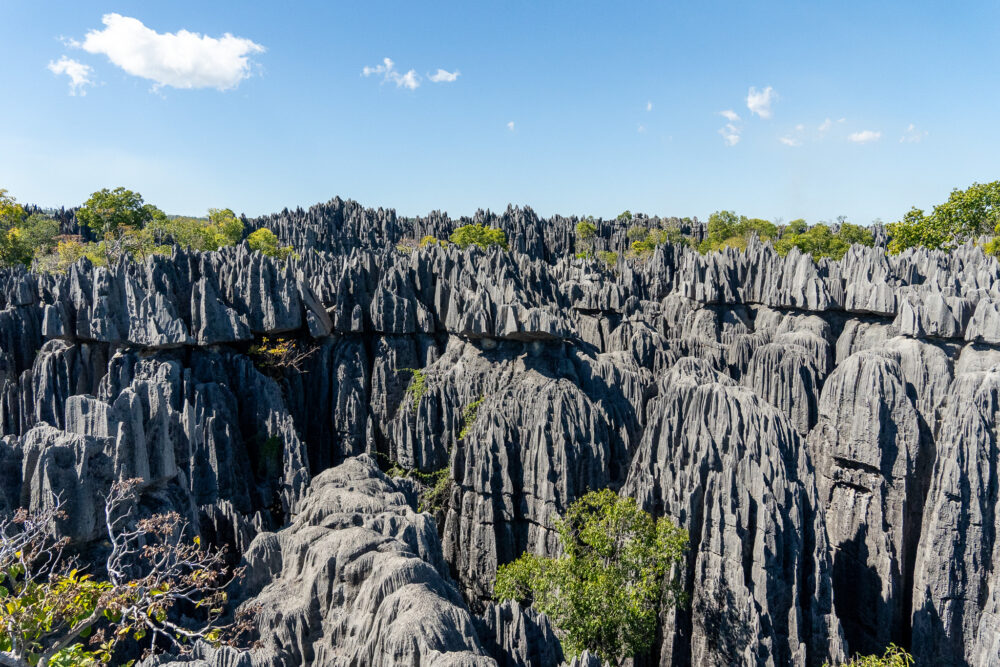
An Adventurous 22-Day Madagascar Road Trip Itinerary
AKA the Grand Circuit. Let’s go over this lengthy route step-by-step so you can easily reach every Madagascar destination on your bucketlist. We’re going to cover the REAL drive time for each drive day as well as what you can expect from the road conditions as of our Madagascar road trip in 2025, because the online information we found was way out of date.
It’s important to note that if you only have ONE driver for the duration of this trip (keep in mind 99% of vehicles in Madagascar are manual transmission), this will be a difficult pace to keep up. While you don’t drive every day, when you do have a driving day, it ranges from 6 to 12 hours of driving time. Obviously, it’s much more manageable to split that between drivers.
Seem a little long? I’ve also got a more condensed itinerary that focuses on the RN7 alone, so you can skip all the off-road adventuring.******
Pre-Road Trip: Antananarivo/Ivato
Before you start your Madagascar Road Trip, you’ll get to explore Antananarivo or Tana.
The Madagascar capital of Tana gets a bad rap. People seem to really hate it. I didn’t LOVE it or anything, but spending a day or two to get on your feet isn’t miserable. To be fair, I didn’t stay in the city limits of Tana; I stayed in the village called Ivato, nearer to the airport, and I recommend you do as well. Especially if you are planning on renting a 4×4 vehicle. Tana is extremely congested, and the traffic here is close to the worst I have ever experienced. I’m talking gridlock that can make 1 KM take 30-45 minutes at rush hour.

There’s also not much to see and do in the city, so save yourself the effort. Another important thing to note for self-drivers is that the streets here are NARROW. Like, fold in your mirrors and hold your breath, narrow. Ivato is a little better, but I still recommend picking up your vehicle at the Road Trip Africa office rather than opting for the hotel delivery. These tight streets are no good when you’re just learning the dimensions of a new vehicle.
Where to Stay in Tana: Tianay Residence
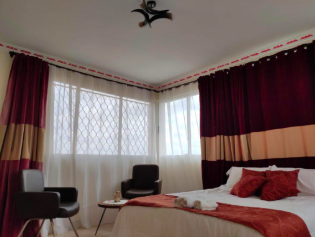

Where to start with Tianay Residence? The rooms were super comfortable and clean, the shower was hot, and the host was super kind. We got home-cooked meals here each night and beers delivered for a super affordable price. To make matters even better, the family donates the profits to the community to help educate the kids of nearby families. This was one of our favorite stays in all of Madagascar.
This place is only a 15-20 minute drive from the international airport. You’re near banks, a supermarket, and several of the more reputable SIM card companies, too.
Day 1: Tana to Antsirabe
- Real Life Drive Time: 6 hours, 200 KM
- Road Conditions: Today’s journey will be on a very busy stretch of the RN7. Expect tarmac but plenty of potholes that will make the journey slow.
Let’s hit the road!
I highly recommend picking the car up as early as possible today. Your first stop is going to be the Carrefour in Tana to get supplies for the duration of the trip. While you will be able to re-up on fresh fruit and veg throughout the country, I would get ALL your staples here in Tana.

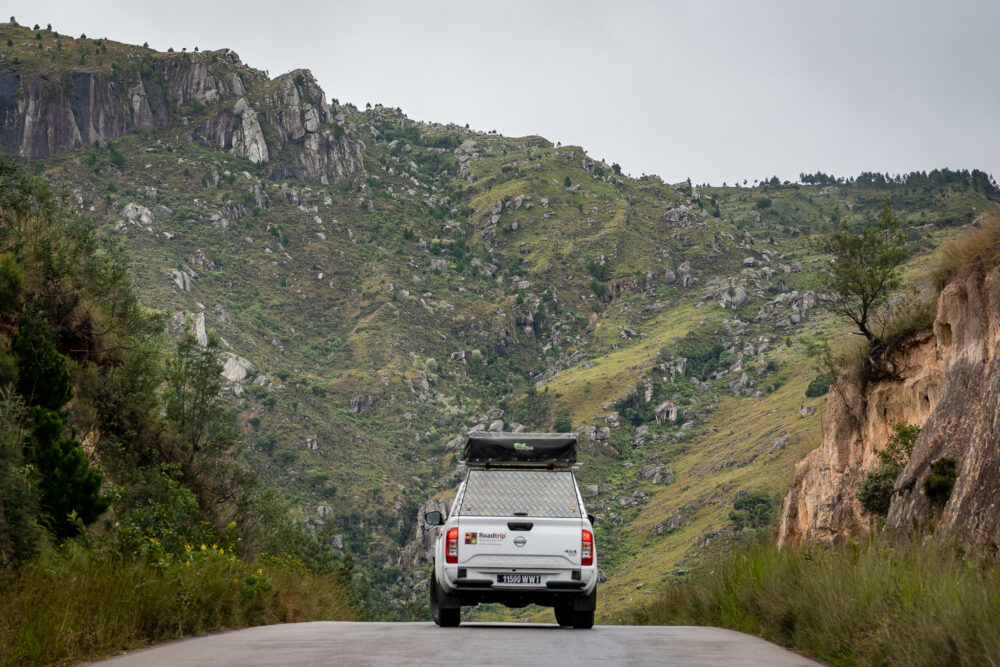
We got rice, pasta, pasta sauce, couscous, beans, canned fruits, canned veg, easy instant meals, lots of French wine (highly recommend this), oatmeal, eggs, potatoes, and other staples. We also bought dish soap, paper towels, two small hand towels, a sponge, trash bags, and baby wipes because we know that is super helpful when it comes to clean up.
Today is little more than a drive day. The scenery will be beautiful, and you’ll probably want to give yourself ample time to snap some photos along the way. This is the one portion of the trip you’ll drive twice. You’ll see many roadside vendors selling unique handcrafted goods like rugs, metal works, and more as you approach Antsirabe. These stalls are a great way to buy unique hand-crafted goods, unlike in tourist towns.
If you find yourself in Antsirabe looking for food, Chez Jenny is highly recommended.
Where to Stay in Antsirabe

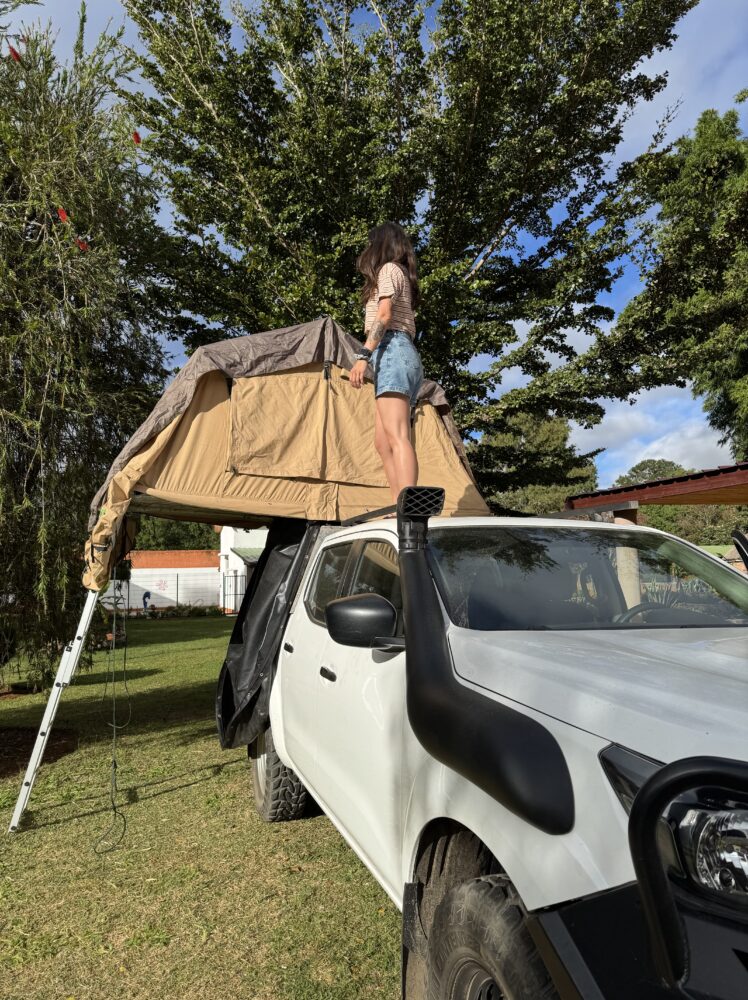
Residence Madalief. This camping spot/hotel is located just south of Antsirabe. The only catch is that you should call them in advance to let them know you are coming. We did not, and found the gate closed when we arrived just after dark. We honked and they heard us after a while, but it was a close call. Camping costs about 40k MGA or $8.90, and they open a room for you to shower.
Day 2: Antsirabe to Ranomafana National Park
- Real Life Drive Time: 7-8 hours, 245 KM
- Road Conditions: Continue on the RN7 with slightly fewer trucks and traffic than yesterday. Potholes are more numerous, and the road is very windy. The final 30 KM has some huge cratered potholes, but overall it’s still tarmac and not bad if you follow the directions below.
- Important Directions: Stay on the RN7 until Alakamisy Ambohimaha. Here you’ll take the RN45 to your destination. Google will try to tell you to take the RN25. This is a horrible, awful road that you’ll probably get stuck on, or at the very least will take you 10x as long as the RN45.
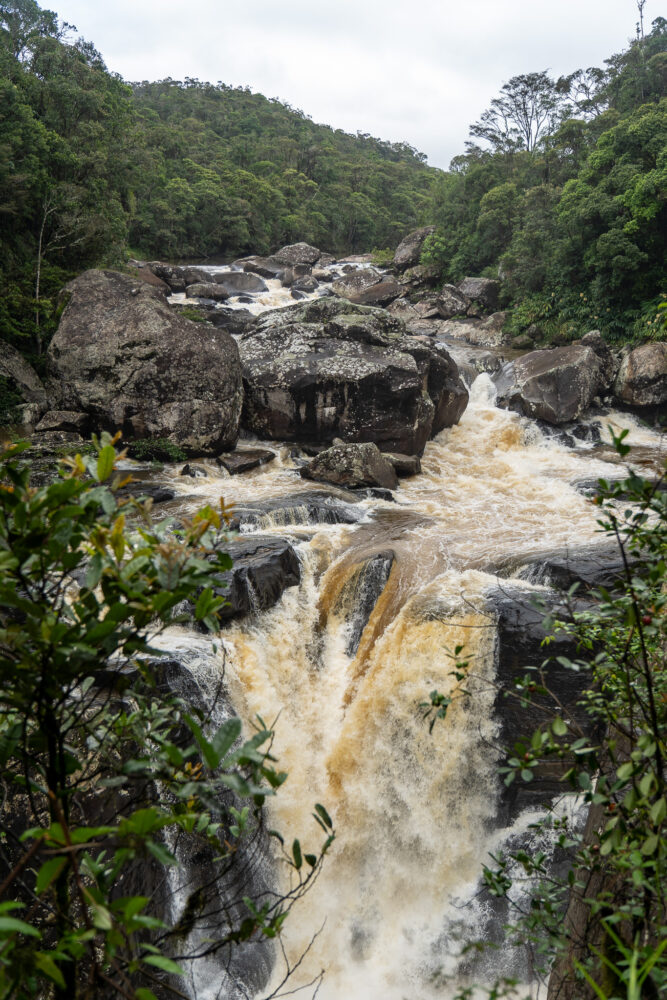
Roadside scenery only gets better today! You’ll pass into the rainforest ecosystem toward the end of the day as you reach your first real destination on this Madagascar road trip. Ranomafana National Park. But be prepared this is going to be a long drive day due to the windy roads.
Where to Stay in Ranomafana National Park
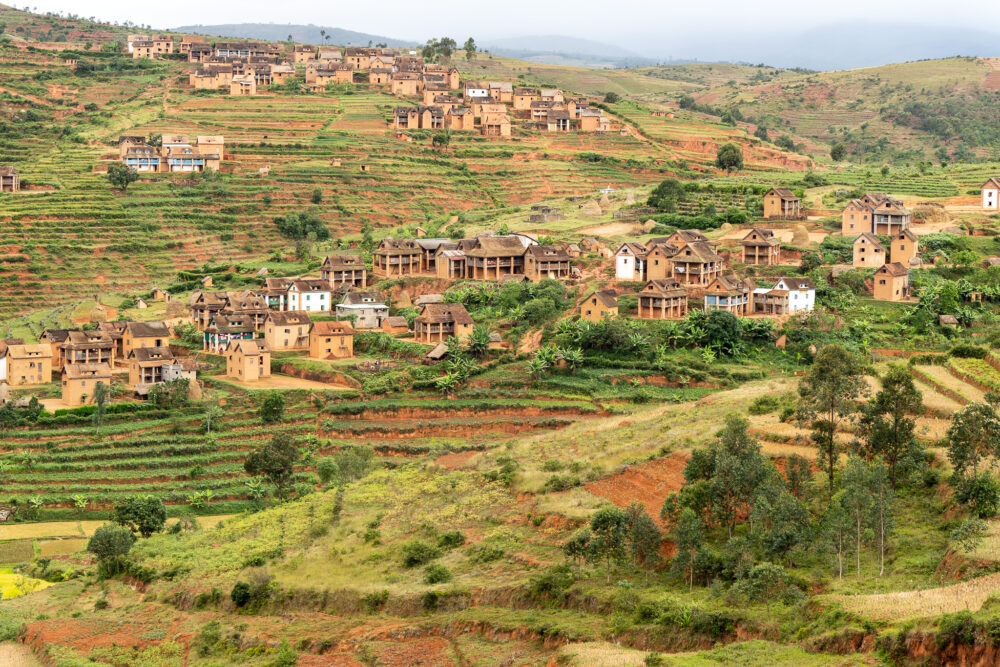
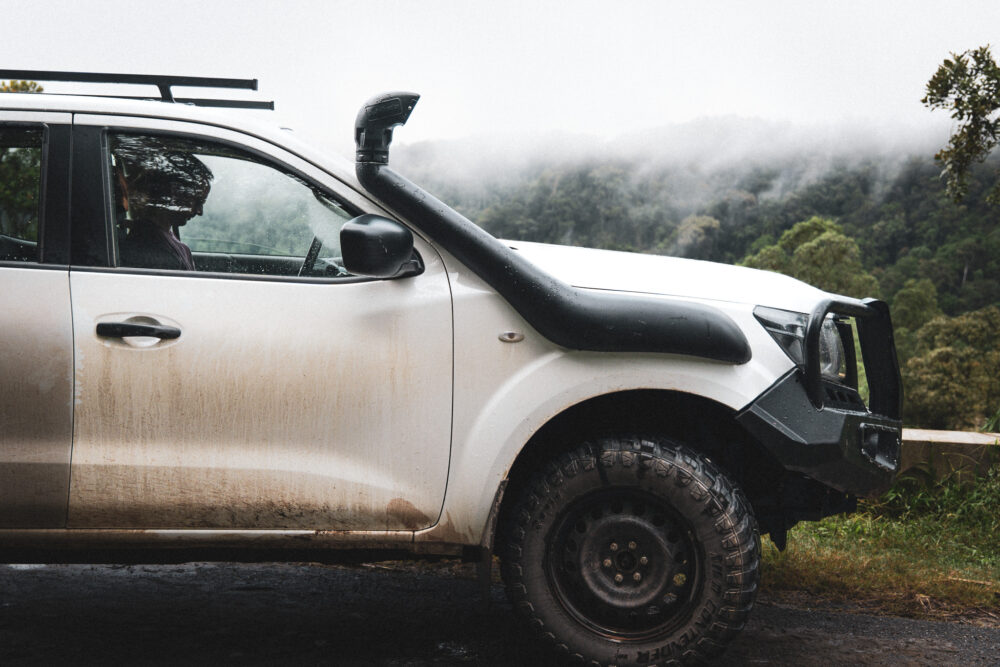
There are two decent options for rooftop tent camping. The first is the more budget-friendly one. At the park entrance (Rianala Gate), car campers are permitted to set up in the sandy area near where the hiking trails start. It’s only 10,000 MGA or about $2.50 for the night. The major downside is that this part of the park is SUPER busy in the morning, so if you plan on cooking breakfast or hanging out at camp, you’ll be swarmed with vendors and other park-goers. The better option, in my opinion, is the parking lot across from Setam Lodge. While it’s closer to the road and costs 40,000 MGA or ~$10 for the night, it’s more private and overlooks a pretty part of the jungle.
In an ideal world, you should stay at the Setam Lodge lot the second night so you can have a slower morning before you hit the road. The first morning, you’ll be hiking early, so it doesn’t really matter.
Day 3: Ranomafana National Park
- Iconic Wildlife to Spot: Greater Bamboo Lemur, Golden Bamboo Lemur, Rufous Mouse Lemur (nocturnal), Milne-Edwards’s Sifaka, Red Fronted Brown Lemur, and more!
- Must-Do Treks: Night walk + 3-4 hour morning trek.
As it was dumping rain the day we chose to visit Ranomafana (it is a rainforest), we weren’t keen right away to do the longest trek. We chose the 3-hour option in the early morning. All treks pass through the secondary forest into the bamboo forest and have a good chance at spotting at least a few lemurs.
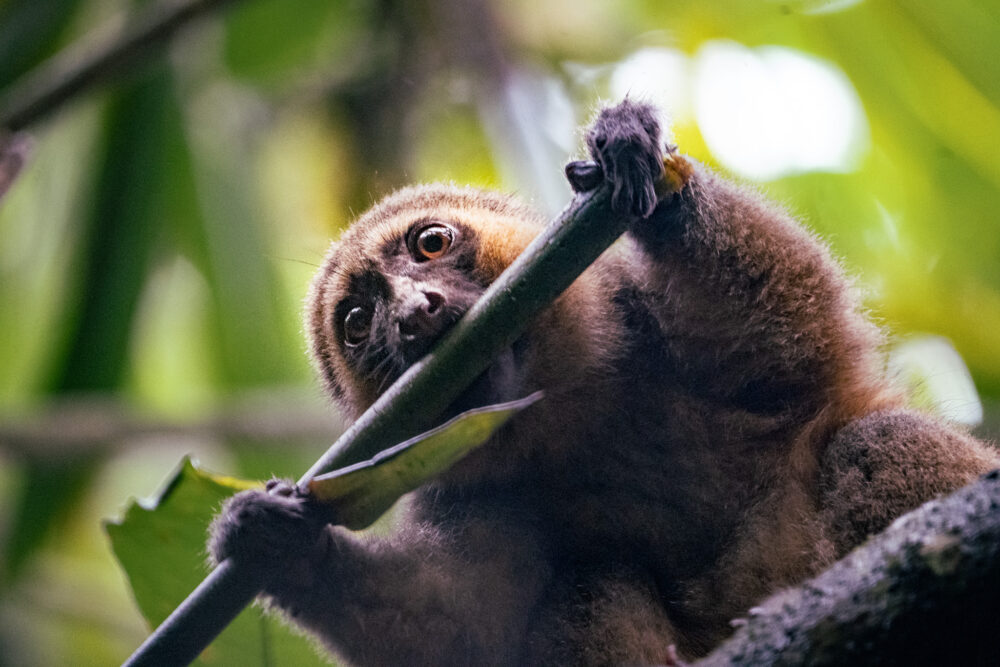


After a successful morning, we decided to cook lunch and then hit the trails again for an afternoon hike. I do not recommend this much hiking unless you are looking for a particular species, like we were. We were absolutely dead after another 3-hour trek that finished with just enough time to get us over to the night walk. All in all, we saw Greater Bamboo Lemur, Golden Bamboo Lemur, Milne-Edwards’s Sifaka, Red Fronted Brown Lemur, Common Brown Lemur, Satanic Leaf Gecko, Mossy Leaf Gecko, and numerous Chameleon species.
We found the hiking in Ranomafana to be moderate in terms of strenuousness. There are a lot of up-and-down hills, so keep that in mind when choosing your trail length.

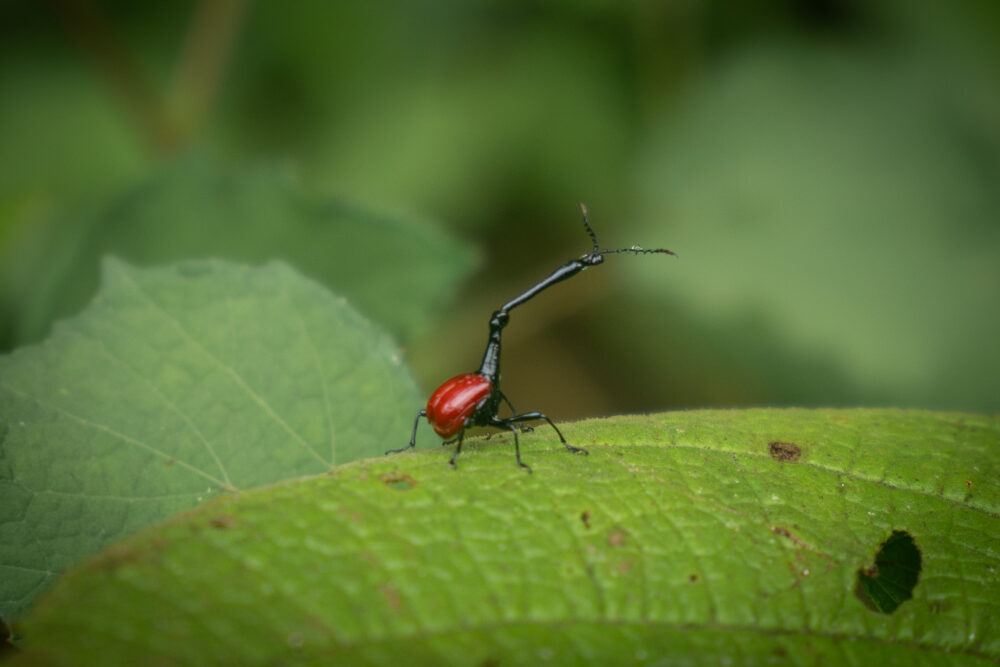
Weather in Ranomafana
This is a rainforest. Please remember to bring layers (including waterproof ones) for all treks and camping in this part of Madagascar.
Should You Do The Night Walk?
There are only a few opportunities to do a night walk on this Madagascar road trip. Ranomafana, Andasibe National Park, and Kirindy Reserve. None of them allow you to hike IN the park, but rather on trails in nearby reserves or forested areas on the border. Andasibe is my personal favorite, as you actually get to explore inside a forest. The Ranomafana night walk is alongside the road, which is kind of a bummer as cars regularly pass by that you have to move for, but the wildlife is abundant.
Another big caveat? If it’s peak season (June-August), 200 people can cram into this small space, which makes it even more disappointing. If you are NOT planning to visit Andasibe, I highly recommend doing at least one other night walk.
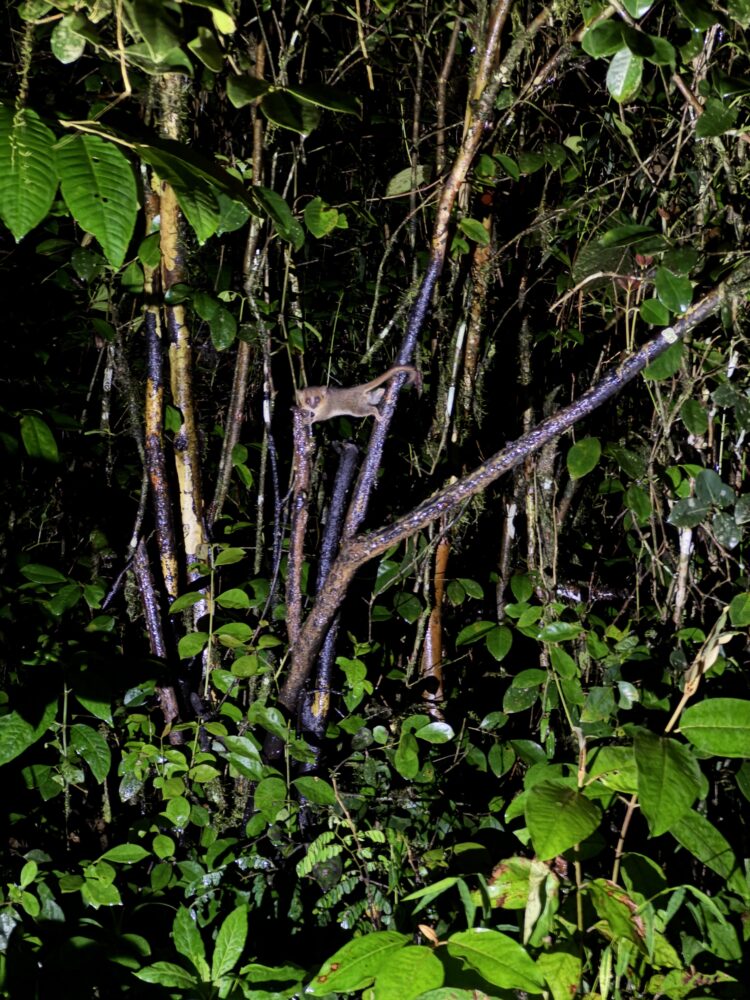
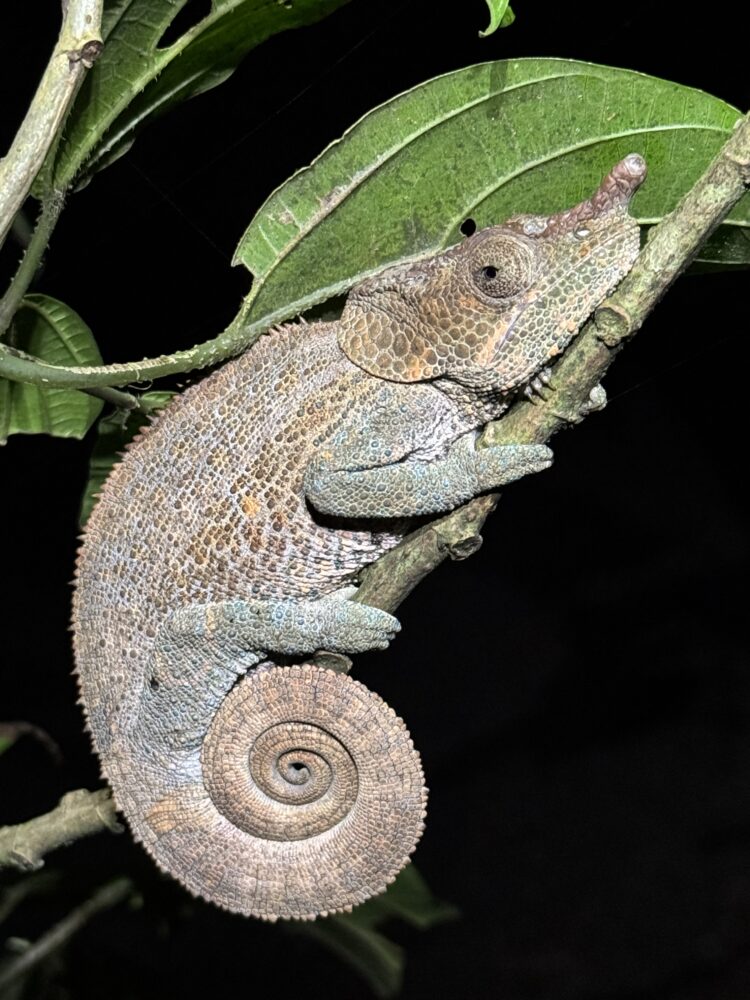
Day 4: Ranomafana National Park to Anja Community Reserve
- Real Life Drive Time: 5 hours, 130 KM (+ 1.5 hours for Anja Reserve)
- Road Conditions: Paved road on the RN7 for the entire journey. You pass through several larger towns/cities on this section, which makes it slower driving than usual due to traffic.
- Must Do Trek: 1.5-hour walk at Anja Community Reserve
We had originally planned to drive straight to Camp Catta in Andringitra National Reserve on this day, but honestly, unless you leave at sunrise and skip visiting Anja Community Reserve…it’s not feasible.
Anja Community Reserve has a few species of animals and offers short wildlife hikes ranging from 1-3 hours. The main reason to visit is the abundance of Ring-Tailed Lemurs. Yes, you’ll probably see them elsewhere in Madagascar, but these have been habituated and allow you to get really close. At one point, I was standing in the jungle surrounded by leaping ring-tails.


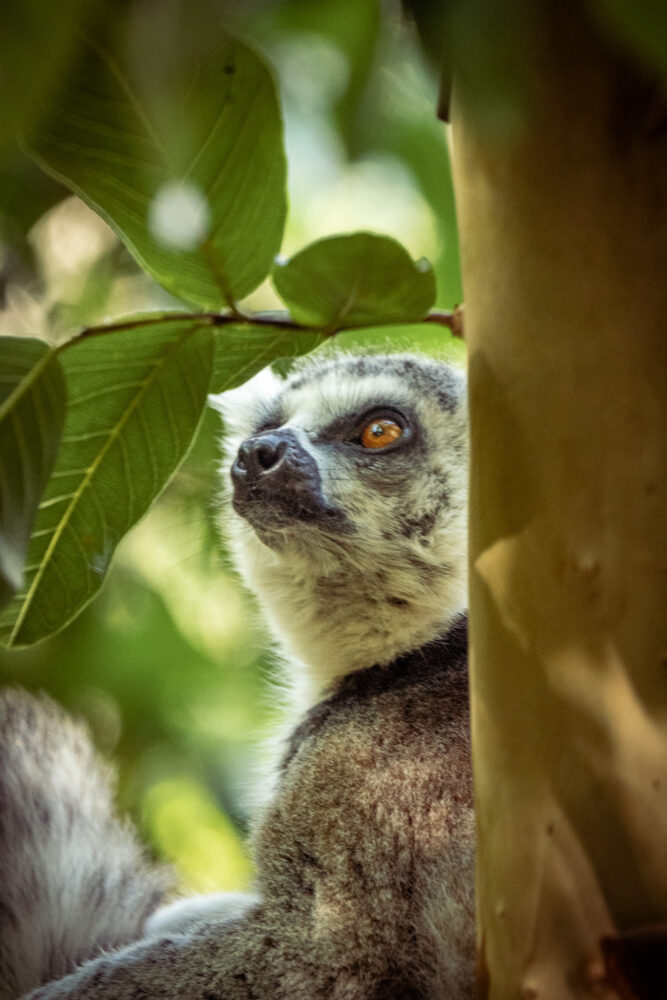
The best time to visit the reserve is in the early morning or afternoon as the lemurs will be most active. If you’re following this itinerary, then the afternoon works best.
Quick Info About Anja Community Reserve. Be sure that you stop in at the TICKET office that has official signs on the cost of entry and treks. This is the only place in Madagascar where a guide tried to overcharge us. The park entrance plus a 1-ish hour trek should be 130,000 MGA or $40 for two people. We accidentally passed the office and went straight to the trailhead, where a guide tried to charge us twice this price.
Where to Stay in the Anja Area
While you can stay in the Anja community area for cheap (around 40,000 MGA or $10), I have to recommend Betsileo Lodge.

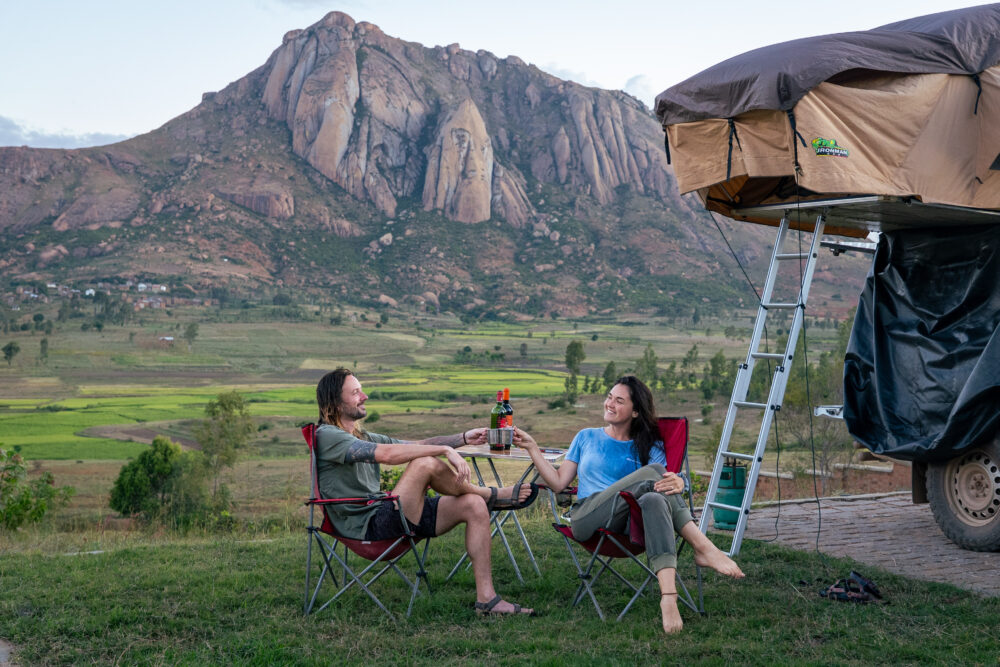
This was the most expensive campsite we paid for on this Madagascar Road Trip, at $30 or 100,000 MGA for the night. But it’s also one of the only campsites in all of Madagascar that had showers, a real bathroom, and a lovely camping setup for rooftop tents that overlooked an epic view perfect for night photography. There is also a pool and a restaurant available if you don’t feel like camp food. Rooms here were pricy, but the camping facilities were more than enough.
Day 5: Anja Community Reserve to Andringitra Reserve
- Real Life Drive Time: 3.5 hours, 60 KM (30 on pavement, 30 on off-road)
- Road Conditions: The first part of the route is paved as you continue down the RN7. But at the town of Vidia, you’ll make a left turn off the pavement onto a dirt track to guide you toward the reserve. There will be a few portions of road (near the first town + community fee) that are tricky to drive but otherwise its a simple dirt road.
This is not a journey you want to make after dark.
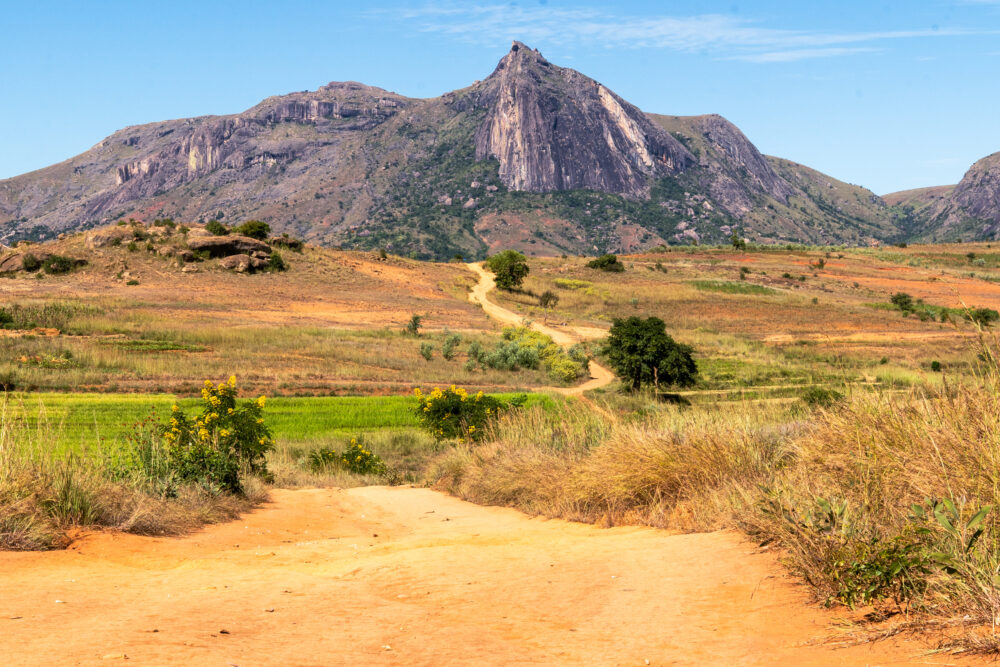
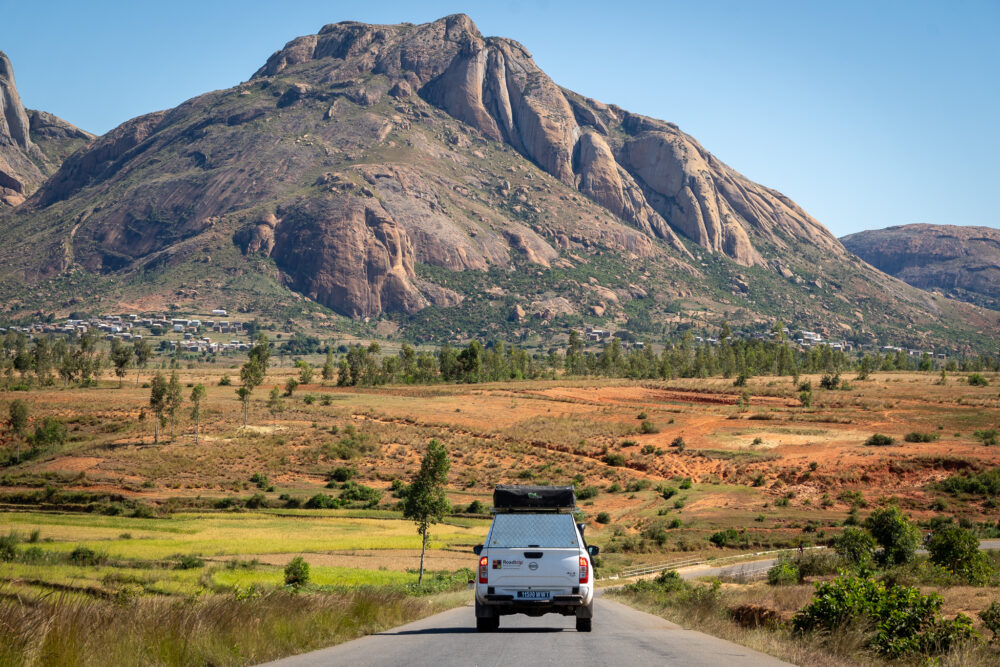
Reaching the reserve requires about 2.5 hours of slow, careful driving on off-road paths. This is easily navigable using an offline version of Maps.me, and you can even use Google Maps for the most part. Almost immediately, you’ll pass through a small town that asks for a 10,000 MGA or $2.50 community fee. Kids here will swarm your car looking for gifts and snacks, so be ready for it.
The first half of the off-road track was in much worse condition than the second half in 2025. If it’s been raining, this will be extremely difficult, and I would reconsider traveling to this region. If possible, Andringitra should not be missed. It’s the best park for views and hiking.
As you arrive at your destination, you’ll be approached for one more “community” or reserve entry fee before you can continue on to Camp Catta.
Where to Stay in Andringitra
Camp Catta is the place to be. Whether you’re thinking of splurging on a glamping room or setting up camp in their scenic overlook, both are excellent options.

There is a swimming pool, restaurant, laundry area, and absolutely killer views of the mountains around you. You also start many of the region’s best hikes from here. Hang around the restaurant long enough, and ring-tails are sure to descend from the mountains looking for easy snacks.
This is another of our favorite campsites on this Madagascar road trip.
Day 6: Andringitra Reserve
- Iconic Wildlife to Spot: Ring-Tailed Lemurs, Chameleons, Boa
If you have extra days to add to your itinerary, I would add them here. (And maybe one extra at the very end in Andasibe National Park) That would make your Madagascar Road Trip closer to one month than 3 weeks ideally.
There are so many neat hikes that you can do here, but some take more than a single day or are so strenous that it could be really exhausting to complete after all the driving days. These are the top three.
- Grand Circuit. This is a full-day hike (6-8 hours) with STUNNING views. It is pretty strenuous and involves a rope-assisted climb to the summit. If you have an extra day to recover, I recommend this hike wholeheartedly. It’s less about the KM distance than it is the elevation gain and exposure that are tiring.
- Chameleon Track. This is the hike everyone should do, no matter the amount of time you have in the park. It offers nice views and some potential wildlife sightings along the way. Try to hit the trail in the morning and expect 4-6 hours of hiking.
- Pic Boby. This is an exceptional hike that summits the tallest peak in the region. It takes 2-3 days in total with porters and camping, so you would need to arrange this in advance AND have several extra days to extend your time in the park. Everyone I met who did it had nothing but excellent things to say. I highly recommend it, if you can muster the time.
You’ll pay according to the trek you wish to do, and you aren’t allowed to venture into the reserve without a guide.
Day 7: Andringitra Reserve to Isalo National Park
- Real Life Drive Time: 6-7 hours, 220 KM
- Road Conditions: Start your day by backtracking 30 km off-road to reach the RN7 again. From here, it’s pavement until Ranohira town, your home base for Isalo.
We left early to ensure that we arrived with plenty of time to scout out a good campsite. This is super important in Ranohira. The town is awful—perhaps my least favorite place in the entire country. This is probably due to the large number of tourists who visit Isalo National Park.

Upon arrival in town, head straight to the park office to find a guide. Outside, there is always a board that showcases the different guides and the various languages they speak. All treks into Isalo start early in the morning, so you’ll want to arrange tomorrow’s hike now. You’ll also be offered a BBQ lunch option to add on to your hike, and it was surprisingly large and delicious, so I recommend it!
Where to Stay in Isalo
There are a few options for your Isalo stay on this Madagascar Road Trip.
Chez Alice is centrally located, a 5-min drive from where you’ll pick your guide up in the morning. They have the best restaurant in town (for reasonable prices) + camping is only 15,000 MGA or ~$4.50 BUT you aren’t allowed to cook here and the parking lot you set up in is far from scenic.
Isalo Ranch or Camping at a lodge in this region. I highly recommend asking one of these properties just beyond town center if you can camp here. It will probably cost around 40,000 MGA ($10), but the views and amenities are WAY nicer.
Wild Camping further south of town (near Isalo Window). The benefits are that this is totally free and BY FAR the most scenic option. I wish this is what we had done, but tired after a full day of driving, we didn’t bother to venture south of town on the RN7. The cons? Isalo is chilly as it is, so be sure to find a place that has a little wind barrier.
In Park Camping Option: You *could* opt to tent camp in Namaza Campsite. It’s about 1 KM up the trail into Isalo National Park and you’ll likely have lots of lemur sightings around camp. But as it’s a short hike you HAVE to tent camp and the sites are developed, not wild feeling. The other downside is that you will need to pay for a 2-day visit to Isalo if you choose this option, or another 55,000 MGA ($12) per person in addition to a 10,000 MGA camping fee. As we really only wanted to stay one day in Isalo for trekking, we skipped this option.
Day 8: Isalo National Park
- Iconic Wildlife to Spot: Ring-Tail Lemur, Common Brown Lemur, Verreaux’s Sifakas, Scorpion, Chameleon
- Must-Do Treks: Black + Blue Pools Trek or Piscene Natural Trek.
If you only have one day in Isalo (which I think is enough), most guides and I will recommend the Black and Blue Pools trek for a few reasons. It’s a half-day trek through all of Isalo’s iconic landscapes and offers the best chance of spotting the Verreaux’s Sifakas, which, to me, was a highlight of the park. Swimming in the natural pools was a quick little bonus BUT far from the highlight.
Keep in mind you have to drive yourself and your guide to the trailhead on a rough dirt road in the early morning so you’ll have to pack up camp. The drive takes about 20-30 min from town.
We made sure to linger with all wildlife and walk to the very edge of the lookout, taking lots of photos, which put us behind the other groups visiting the park by quite a bit. This is vital because you don’t want to end up at the pools at the SAME time as everyone else visiting the park. We got the place all to ourselves.
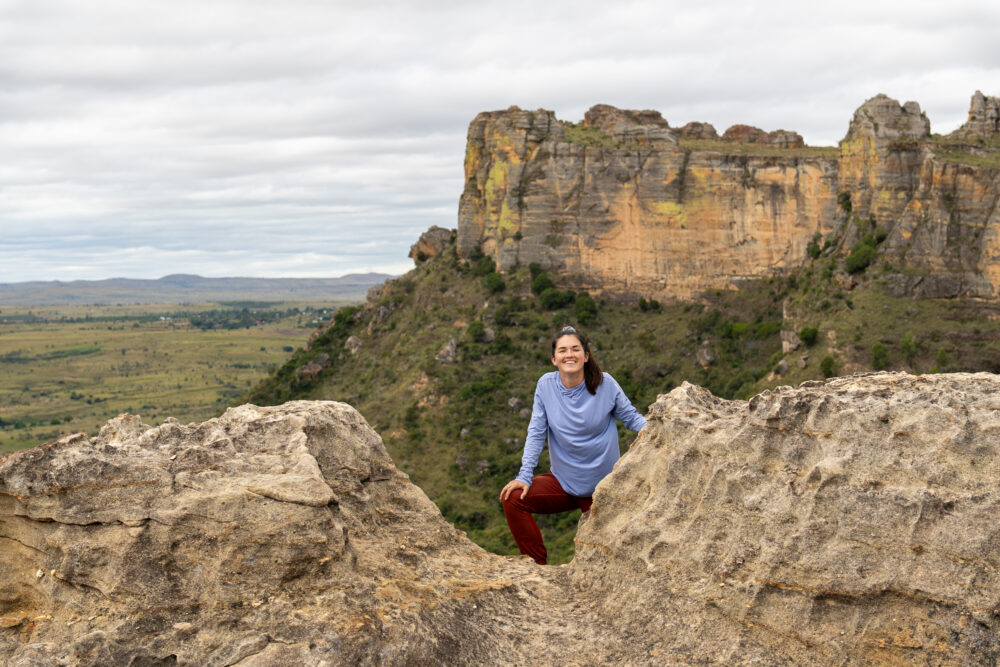

What We Skipped: The Isalo Window is one of those attractions that everyone says you “must-see,” but it gets crazy crowded at sunset. As we’re from the US and have been blessed with attractions like Bryce Canyon in Utah, we felt we could skip this one.
The landscapes here are lovely, and it was one of my favorite hikes in Madagascar, but I didn’t really feel the need to explore the region more. At the start of the hike (and the end), you’ll hang out in Namaza Campsite to see some habituated lemurs and eat a delicious Zebu (beef) BBQ if you opted for the included lunch.
Weather in Isalo National Park
Isalo is a cold-weather region of Madagascar. We visited the park at the end of April, and it was quite chilly. I still took a dip in the natural pool, but be sure to bring a sweater for camping and the hikes.
Day 9: Isalo National Park to Ifaty
- Real Life Drive Time: 8-9 hours, 265 KM
- Road Conditions: Your last day on the RN7, but “pavement” is a stretch here. It’s far more potholes than tarmac and one of the worst driving days in the country. Settle in, because this is going to be a slow one. Don’t worry though, for the first part out of Isalo, it’s nicely paved.
You’ll pass some really STUNNING scenery as you make your way from the highlands to the coastline.
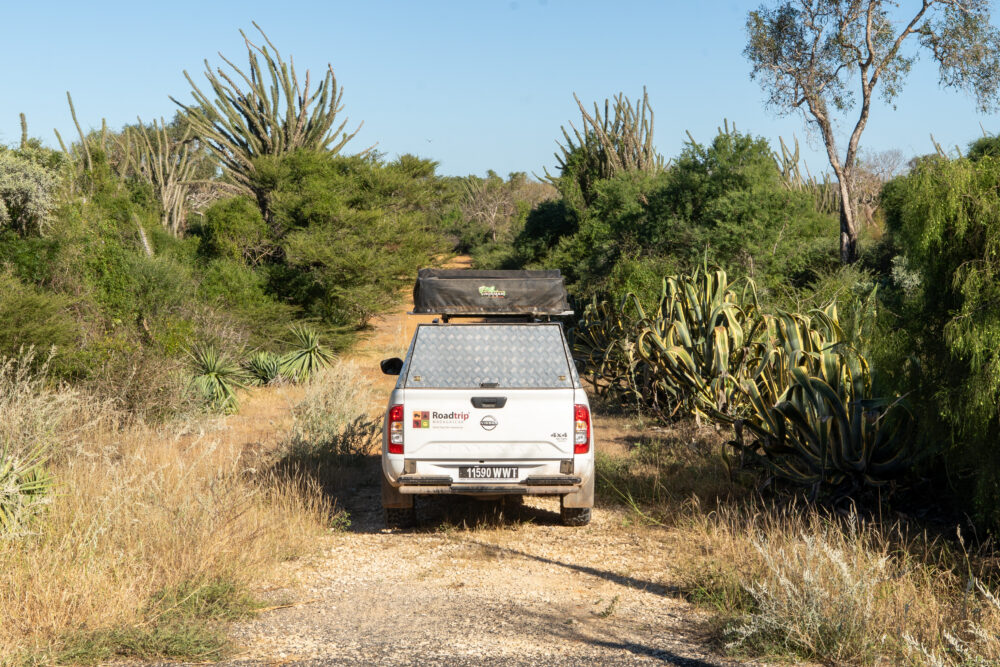
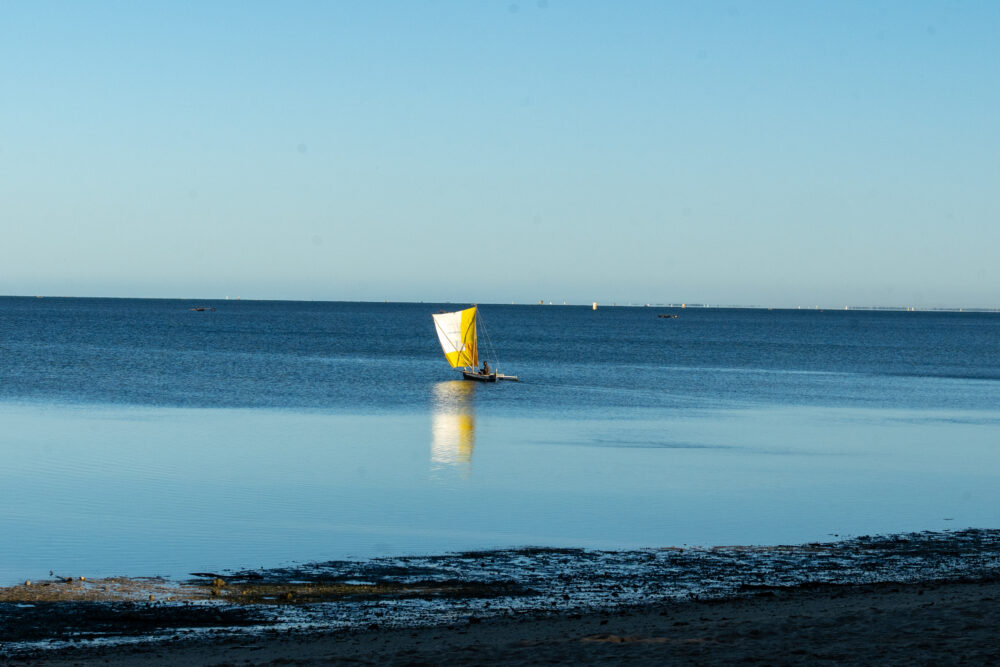
I recommend staying in Ifaty rather than Tulear because Tulear was wildly disappointing and rough around the edges. While neither destination is an excellent beach destination, Ifaty was a little more so.
After today’s long drive, we decided on a whim to book a beach bungalow rather than try to find camping. Mostly because the high population density made finding wild camping impossible, and we didn’t want to venture door to door asking for parking lot camps.
Where to Stay in Ifaty
Our bungalow search in Ifaty led us to Sur La Plage Chez. A basic room was around 100,000 MGA ($22) for the night, and we cooked dinner on our beachy patio to save money. It also had secure parking for the car and a lovely beachfront restaurant for breakfast and sunset beers. Rooms were basic, but comfortable.
!IMPORTANT PISTEUR INFO!
If you’ve rented your car with Road Trip Africa, you can add a Pisteur (ride-along guide) from Tulear to Morondava. Three possible routes connect the two cities.
- Route 1: Direct to Manja on RN9 (2 days to Morondava)
- Route 2: Follow the west coast region to Manja + then onward to Morondava (3 days to Morondava)
- Route 3: Follow the difficult west coast route via Belo Sur Mer (3 days to Morondava)
Route 2 + 3 requires a pisteur from the company due to the quicksand and difficult navigation.
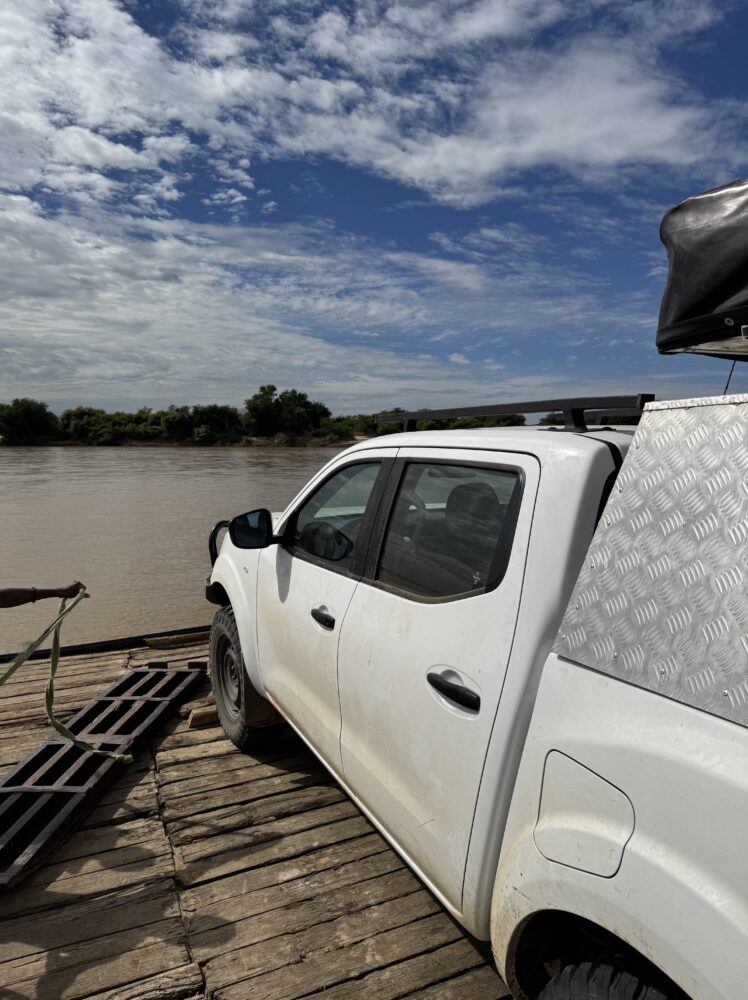
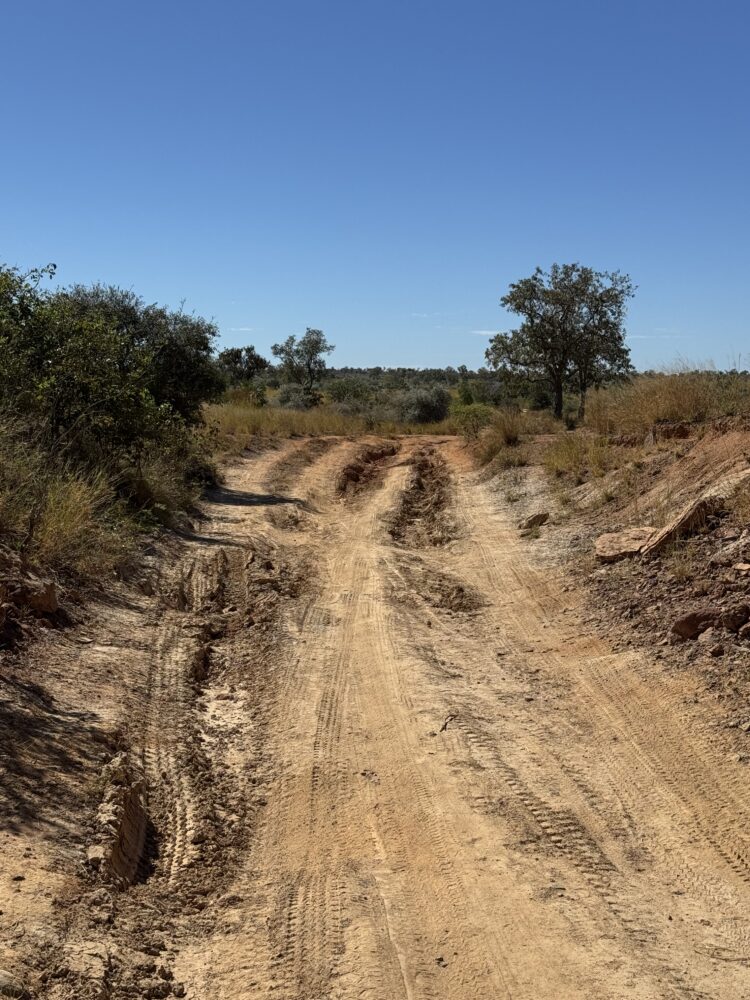
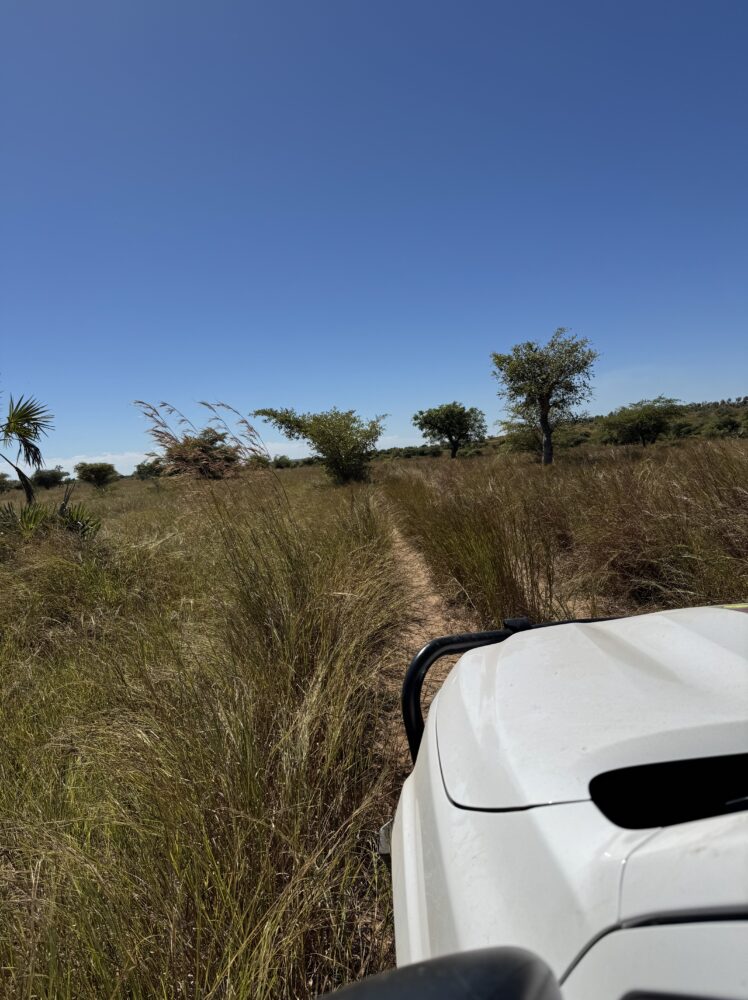
Route 1 is what we chose + it does not require a pisteur BUT the onward journey from Manja to Morondava is treacherous and we absolutely wished we had one. We got very lost attempting it ourselves and had to return to Manja after a full day (and lots of petrol) wasted. I’m going to write this blog post below as if you are short on time and confident you can do this route yourself! AKA route one without a pisteur. Because it is possible with the correct information and decent driving skills.
If you have the time, we recommend taking route 3 with a pisteur as it allows you to experience unique ecosystems, and if you have to have the pisteur anyway…why not?
Day 10: Ifaty to Manja
- Real Life Drive Time: 4.5 hours, 250 KM (includes one crazy ferry)
- Road Conditions: Tarmac as smooth as BUTTER. The RN9 must be a brand-new road built in 2025 because it is flawless. This is the best road you’ll drive in Madagascar. The only break in the tarmac is when you’ll hop on the float ferry to cross the river. You’ll have to drive across lots of sand to the wooden ferry and, with the assistance of locals, maneuver the car onto the raft.
The ferry should cost you 60,000 MGA. They will start with something unreasonable like 350,000 MGA, but I promise haggling like this is normal. Since so many people will help you, have some small bills ready to tip some others. But warning, be prepared for chaos.
GAS UP IN IFATY.
You won’t see another gas station until Morondava. While it’s technically possible to get gas in Manja, it’s of questionable quality, and you probably don’t want it in your car. There is no station; it’s just in jugs. You’ll also want one jerry can of fuel as a backup when you leave Ifaty.
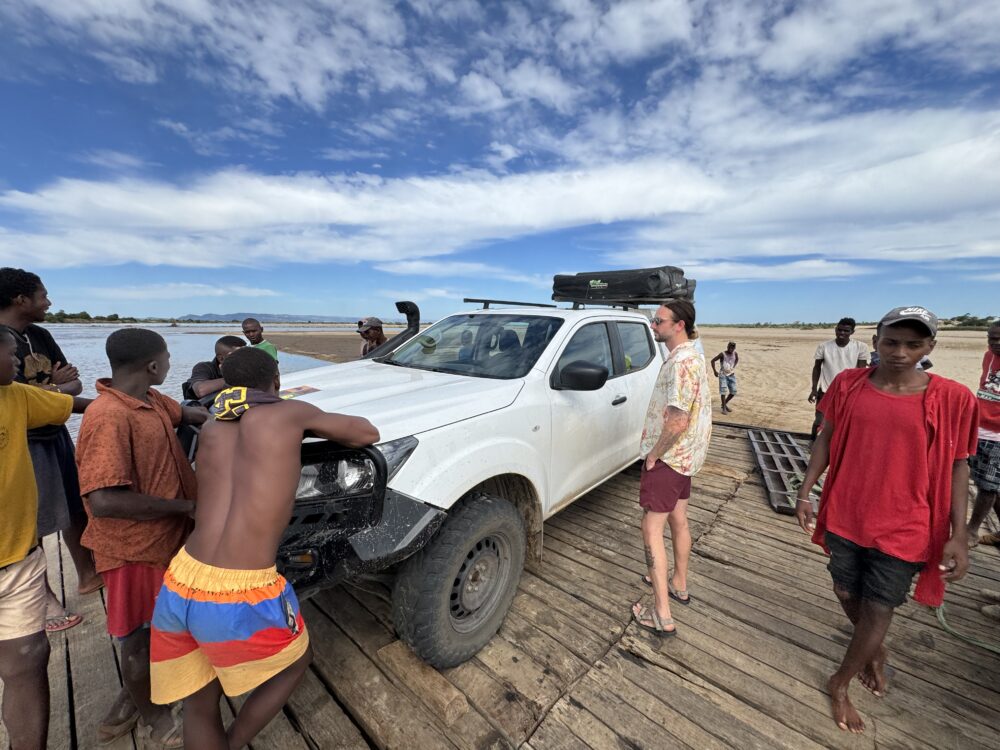
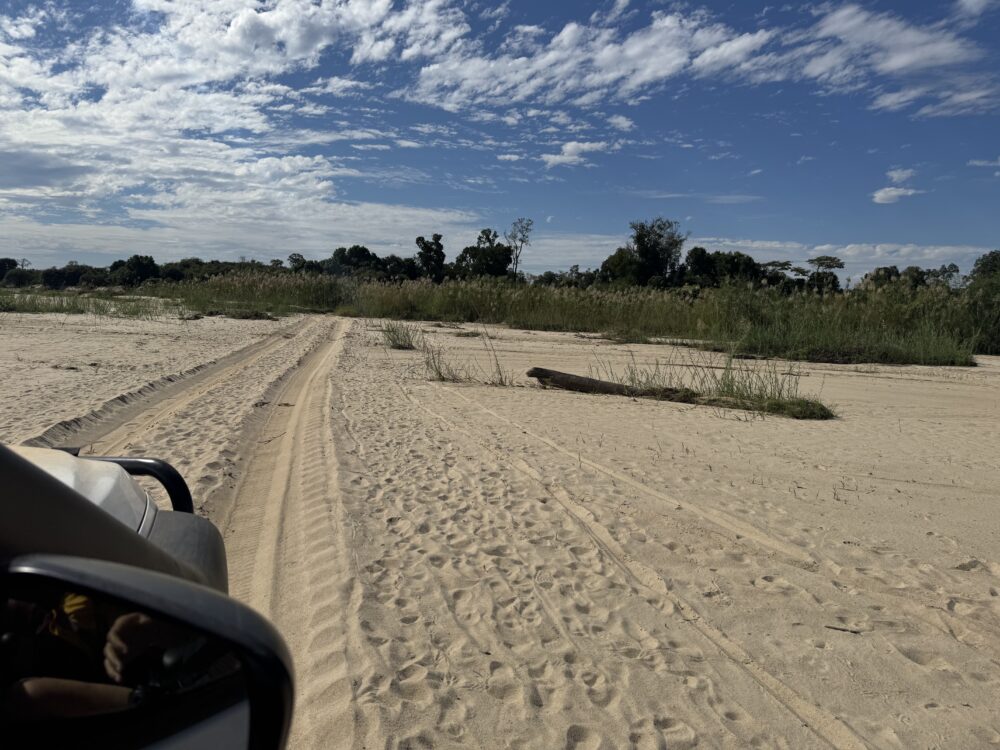
Where to Stay in Manja
There is only one place to stay in Manja. Hotel Kanto. Everyone on a Madagascar Road Trip stays here. We camped with our rooftop tent in the enclosed area and had access to some very rough-looking restrooms near the restaurant area. Camping was 20,000 MGA or $5.
Day 11: Manja to Morondava
- Real Life Drive Time: 8 hours, unknown KM
- Road Conditions: Today is 100% off-road driving. Expect dirt tracks, water crossings, some challenging navigation, and, depending on the time of year (Late April to May), some tricky muddy areas.
- Directions: DO NOT TAKE THE RN9 TO MORONDAVA. This is not the correct route. Instead, download Maps.Me and locate the road near Hotel Kanto Restaurant (opposite side of town) labeled Manja—Morondava Piste.
Today is the day you’ll probably wish you had a pisteur. But if you get on the correct Maps.Me route, you just have to follow it. The key piece of information is that you will have some HUGE water crossings (but there are always locals there to guide you across), and do not take the RN9.
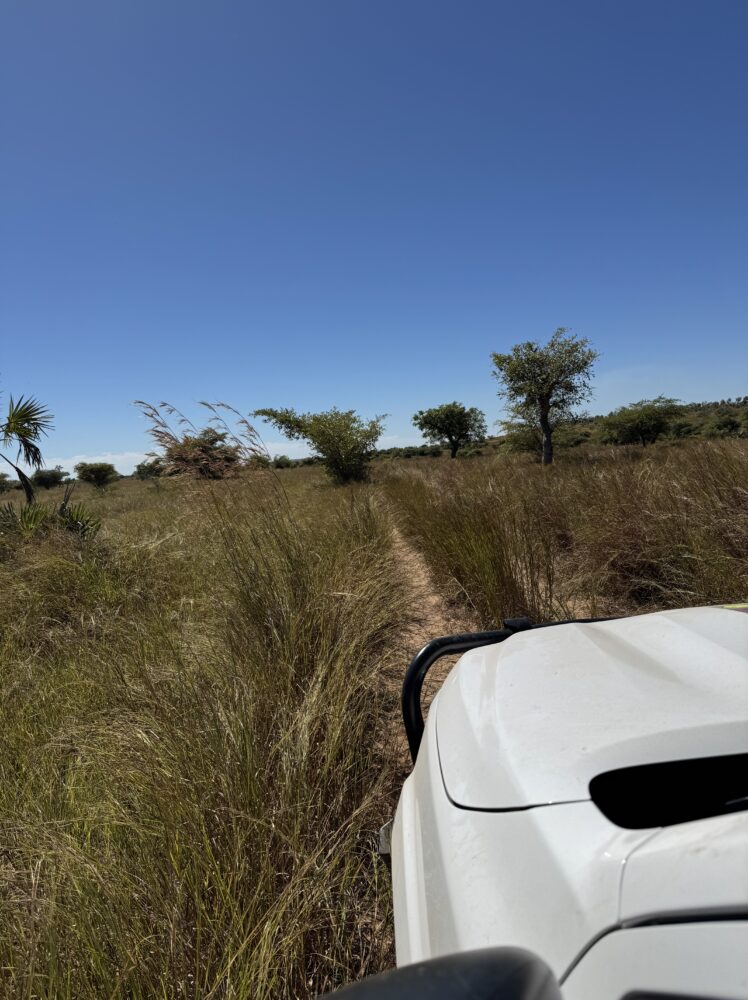

I highly recommend getting some small bills (1,000, 2,000, and 5,000 MGA) to give to people who help you out. They will also happily take 500s, but that’s like $0.11.
Where to Stay in Morondava
Assuming you reach Morondava, the best option in town is Havana Hotel. It’s super affordable at around $18 per night with A/C. Beds are comfortable, but the Wifi rarely works (that’s pretty standard in Morondava). If you want a pool, you can opt for Select Hotel for $20 per night. Just be warned that pools in Madagascar are typically a little milky and for some reason, often closed for maintenance.
Day 12: Morondava
Finally a day of rest???
Not really. You’ll need to re-up on fuel, cash, groceries, and water here. Morondava is one of the only places outside of Tana where you’ll have access to city amenities like grocery stores and ATMs.
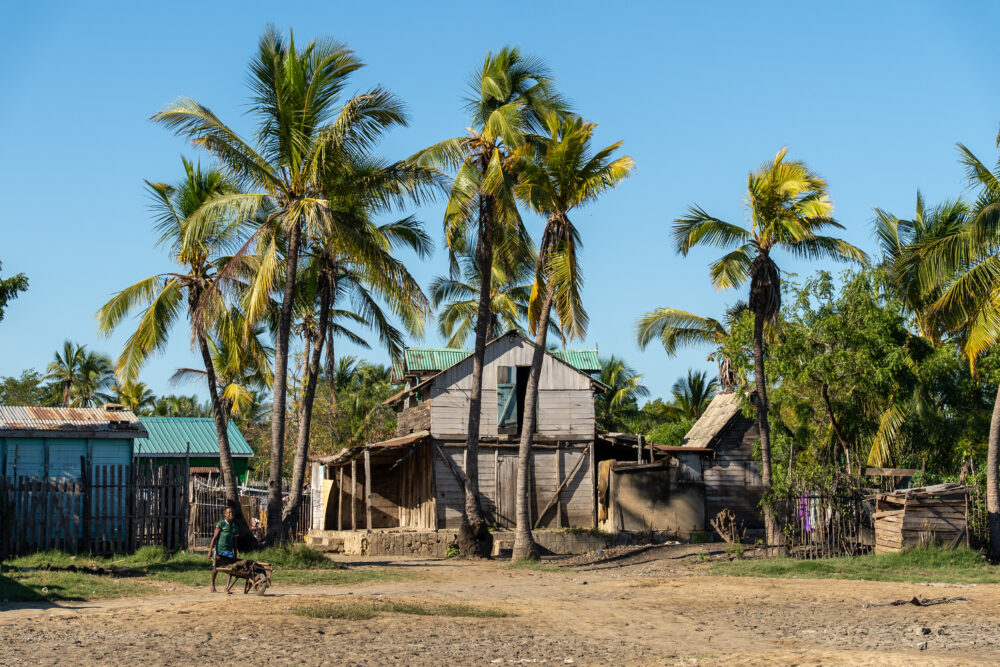
Before embarking on your next excursion, you’ll need a weeks worth of stuff. Don’t expect to be able to pay anything with card. Even the gas stations in Morondava didn’t accept card as the network is often down.
The hot pink Baobab Bank in town doesn’t charge an ATM fee.
I loved Morondava. It feels beachier than the southern cities of Ifaty and Tulear. You should definitely stroll the beach at least once.
Best Places to Eat in Morondava
Add these eats to your Madagascar Road Trip itinerary.
- Bleu Soleil. Seafood on the beach. The Gambas was especially tasty.
- Select Restaurant. Huge filling breakfast from a kind woman and tasty fresh bread.
- Boulangerie Pâtisserie Lawmika. Amazing sweet/savory pastries and drip coffee! They also have espresso available.
Day 13: Morondava to Kirindy Reserve
- Real Life Drive Time: 1.5 hours, 55 KM
- Road Conditions: A mixture of pavement and flat easy off-road track. If traveling in May there may be some mud and one water crossing near the iconic Baobab Ave.
- Directions: Put “Kirindy Village” into Google Maps. Otherwise, it will direct you south to Kirindy Mitea National Park. This is the wrong one.
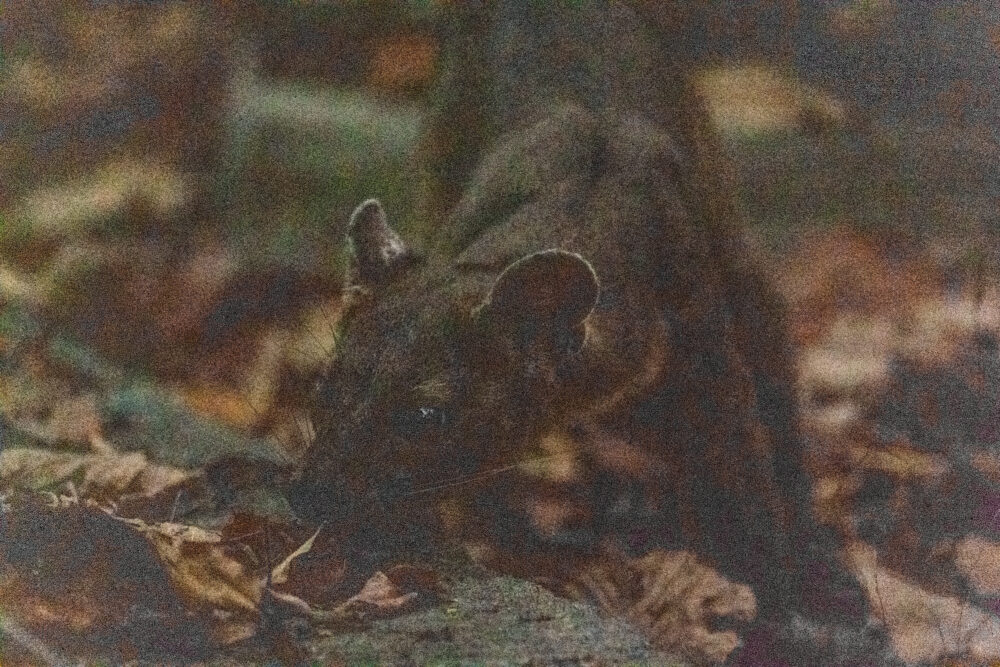
Today, is an easy drive past the famous Baobab Avenue to another lesser-visited wildlife reserve. You’ll have time to see the Baobab’s on the return trip too, so don’t feel like you need to spend a lot of time here. Take your time in Morondava because it’s a short drive day.
Where to Stay in Kirindy
Kirindy Village has nothing but super fancy resorts. Fortunately, the BEST place to stay is the entrance to Kirindy Reserve itself. This is the only place in Madagascar where you are likely to spot the elusive Fossa. A cat-like species that hunts lemurs. Camping is included in your reserve ticket (50,000 MGA). Fossa come straight into camp here in the Dusk and Dawn hours.
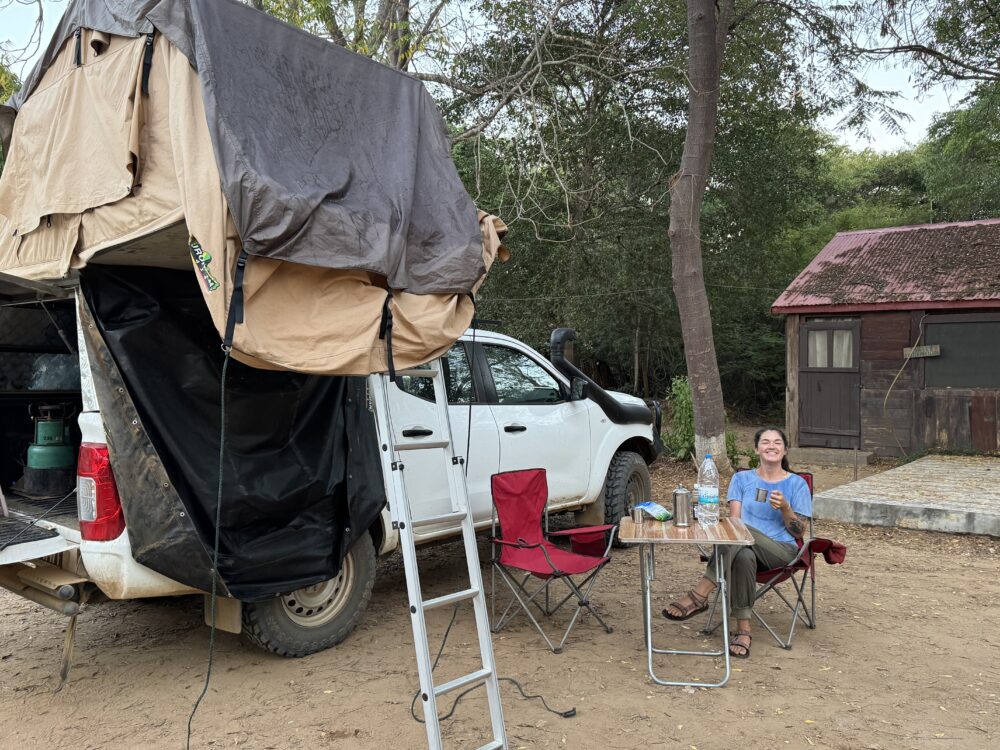
If you’re interested in seeing Sportive Lemurs, Brown Mouse Lemurs, and a variety of Chameleon species, I recommend taking a night walk in the reserve this evening as well. You’ll be leaving far too early tomorrow for a morning walk. But again, I think the BEST night walk is in Andasibe National Park.
Day 14: Kirindy Reserve to Tsingy de Bemaraha
- Real Life Drive Time: 10 hours, 180 KM
- Road Conditions: This is the road that you’ve been warned about. Despite its status as a national highway, you can expect a simple dirt track in the best of times. In the worst sections, you should expect thick, sludgy mud at least 2 feet deep and water crossings that crest the hood of your car. The road is only open from May to October and will be at its worst in May. You also have to take two separate raft-style ferries that cost 95,000 MGA ($20) and 30,000 MGA ($6.50) one way.
- Directions: Fortunately, the route is straightforward to follow on Maps.me. It is also well-traveled, and you’ll have ample opportunities to ask around if you somehow manage to get lost.
Road Trip Africa requires you to rent the Nissan Navarro if you plan to drive this route yourself. For good reason. You need the power of this vehicle to press on through the deep mud and long water crossings.
There are a few things to keep in mind on this travel day. For one, the first ferry is only 1.5 hours or so from Kirindy Reserve. You should aim to arrive around 9-10 AM when the first ferries start. This is the longer ferry, but it will be a downstream ride today lasting only 30 minutes or so. You will probably have to wait for it to fill up before it departs, however. This one holds 3-4 vehicles.
On the other side of the ferry is a small town called Belo Tsiribihina. Here, you will find the infamous Mad Zebu restaurant. They open at 11 AM. It is 100% worth stopping in and waiting for a meal here. The food was by far the fanciest and best we had in the country. The chef/owner previously worked in a 3-star Michelin kitchen in Paris before moving back home to start his own place. A Madagascar road trip highlight for you.
Second Half of the Tsingy Drive
The road beyond Belo Tsiribihina to Tsingy is more of the same and slow. It’s going to get worse as you get closer and closer to Tsingy. (But hey, that means you start with the worst on the way back!)
We traveled in May, which meant the roads were at their worst. But locals hang out near the most difficult spots and assist drivers in crossing the mud/water or getting unstuck when that inevitably happens.
The final ferry is much smaller and only takes about 5 minutes to cross. But the road right before you reach the ferry is always bad. This is because the area is low-lying and filled with cultivated rice fields. So, prepare yourself for that. Once across this ferry (hold on to your ticket because they make you pay for a round-trip ferry ride here), you’re in Tsingy town and can head to your hotel easily. This ferry “closes” at 6 PM.
Today, takes the full daylight day to drive. So, as much as you might want to, don’t take too long of breaks or stop for too many photos.
Where to Stay in Tsingy
Tsingy has only a few hotels, and one hotel that allows rooftop tent camping. Unless you are on a very tight budget, I suggest staying at one of the resort hotels while in Tsingy as the hiking and driving here are very strenous. It’s not fun to add packing up camp and cooking to your already long day. If you insist on camping, you’ll have to head to Tanankoay which is the furthest hotel from the ferry.

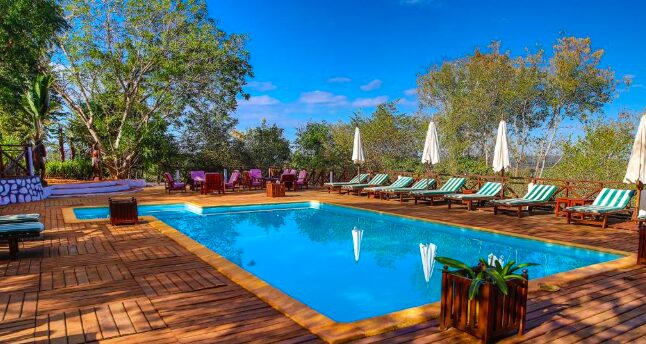
Despite what the Google Reviews state, I HIGHLY recommend you stay at L’Olympe du Bemaraha. If you make your booking on Booking.com here, you’ll get the best deal. Rooms are very basic, power is generator-based and only certain hours (all standard for Tsingy hotels), but the restaurant here is good, there are many communal spaces, the view and the pool are excellent.
Day 15: Tsingy de Bemaraha
Today, I suggest a REAL rest day.
Drink some cold beer, enjoy a book by the pool, or if you’re feeling hugely ambitious, you can head out on a morning or afternoon visit to the “Little Tsingy.”
This is not too far from Bekopaka, in fact, it’s close to the ferry, and you can easily see it on Maps.me. You will have to book your visit at the ticket office in Bekopaka ahead of time, as you need a guide. This is mainly recommended for people who want to check and see if they are afraid of heights before committing to the Grand Tsingy tour tomorrow. We did not do this and felt fine about it.
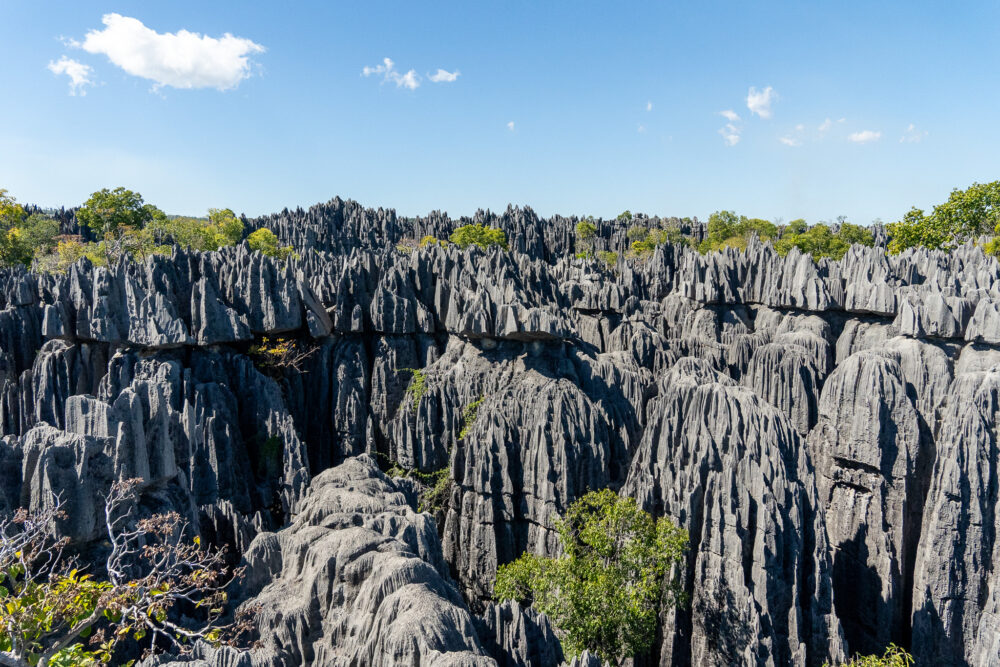

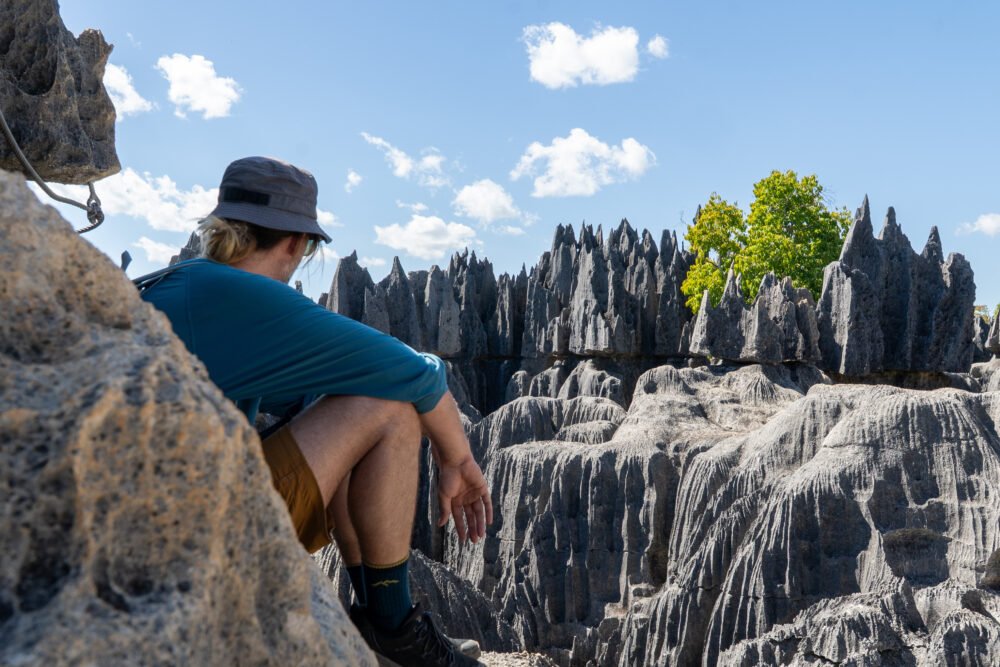
At some point today, you should go to the ticket office and purchase your Grand Tsingy tickets ahead of time and secure your guide for the morning. If you wait until morning to do it, it TAKES FOREVER. We waited over an hour. The office is open from 6 AM to 4 PM.
Where to Eat in Tsingy
There are a few local restaurants in Bekopaka worth trying, too. It’s far cheaper than the resorts and let’s you try more local cooking. One of the rare places to take advantage of local food on this Madagascar Road Trip.
Day 16: Tsingy de Bemaraha
- Iconic Wildlife to Spot: Decken’s Sifaka, Red Fronted Brown Lemur, and Chameleons.
- Must-Do Treks: Grand Tsingy
Now that you’ve had a day to relax and unwind, it’s time for an early morning hike to Grand Tsingy. This part of Madagascar is extraordinarily hot, and this trail is exposed for the entire time you’re on the Tsingy itself so it’s very important that you get an early start.
Hopefully, you prepared your tickets yesterday, so you can just swing by the office to pick up your guide and your via ferrata harnesses.
The drive from Bekopaka to Tsingy takes 1-2 hours, depending on how bad of shape the road is in and how often people get stuck. It helps to be the first car that sets out, so you don’t get stuck behind OTHER vehicles that get stuck in the mud. This is probably the worst road on this Madagascar road trip.
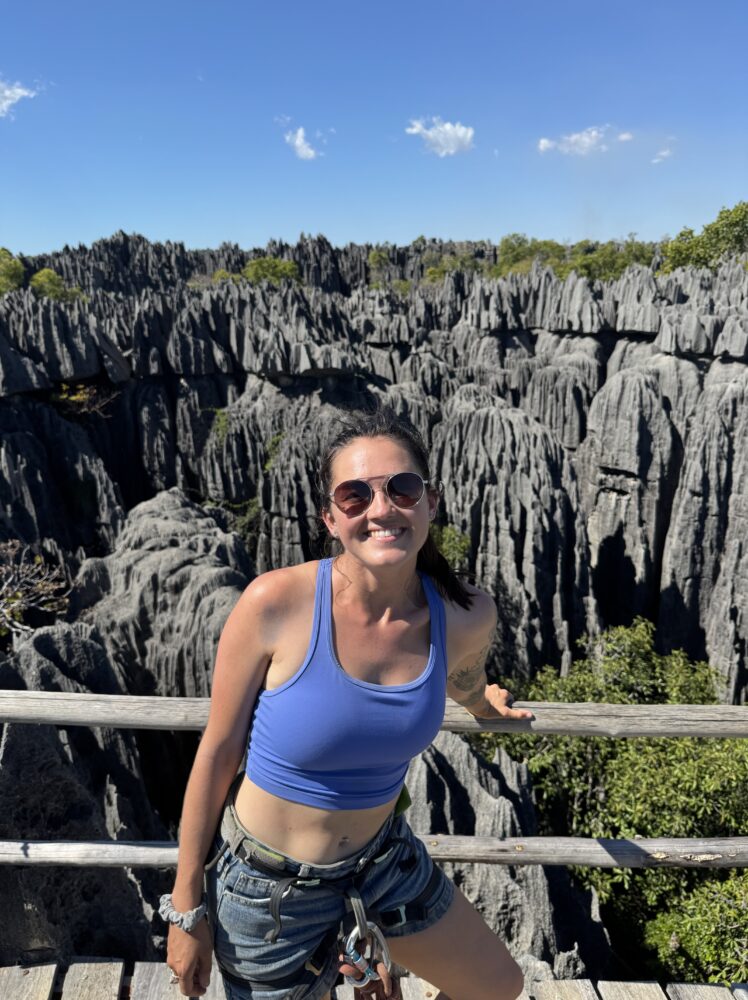
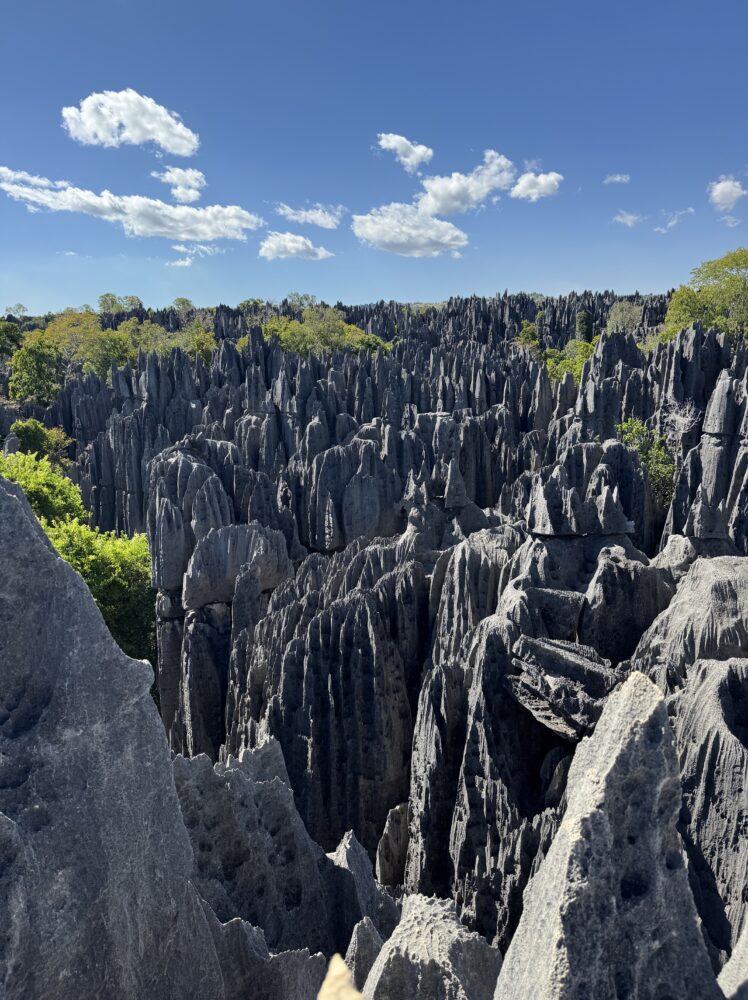
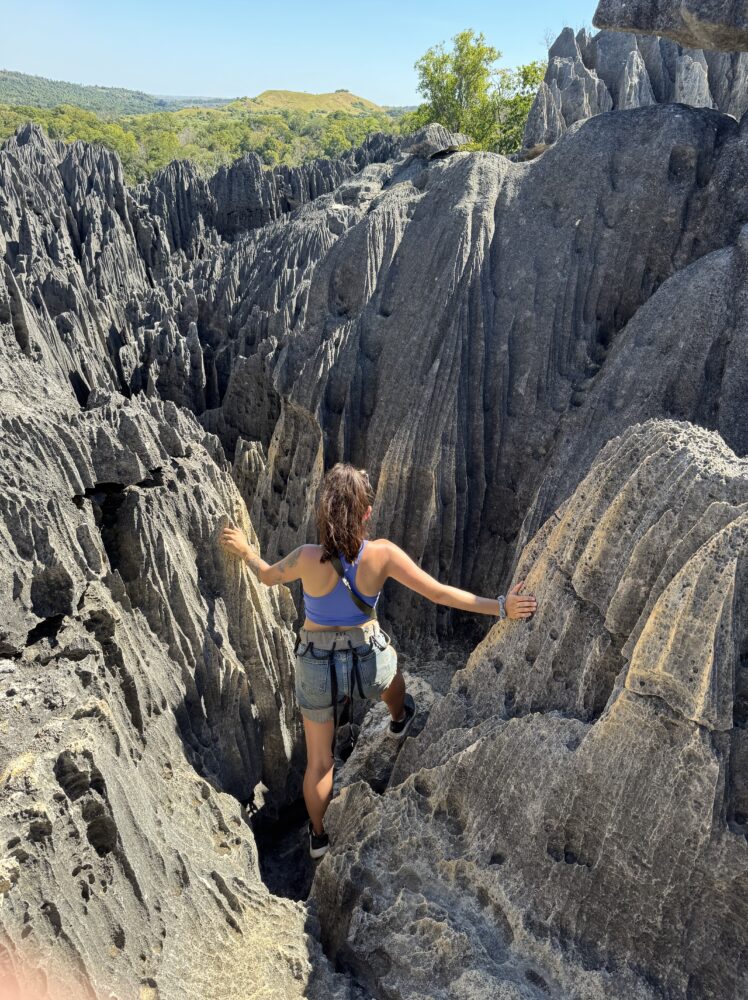
You’ll probably have worked up a sweat by the time you even reach the trailhead. From here it’s only a 6 KM hike through Grand Tsingy but you’ll take your time looking for wildlife in the forested region before ascending the via ferrata lines up to the top of the Tsingy.
This is not a good attraction for those who are scared of heights.
While the hike itself was not grueling, the sunshine was. Thanks to the roads and getting our tickets in the morning, we hiked from 10 AM to 2 PM with a large crowd of people. It was about 35 degrees C (HOT) and we often had to wait in the beating sun for the people in front of us on the via ferrata lines. It get congested easily so it’s important to try to get there before the others.
What to Bring
- Snacks.
- Camera.
- 1.5 liters of water per person.
- Sunglasses.
- Sunhat.
- Long sleeves.
- Sunscreen.
Day 17: Tsingy de Bemaraha to Baobab Avenue
- Real Life Drive Time: 11 hours, 180 KM
- Road Conditions: You’ve already driven this road! You’ll make the long drive back the way you came. The only difference is that the long ferry will now take closer to 1 to 1.5 hours as it is navigating upstream in this direction. Leave at dawn to make this whole drive before sunset.
Sunset is often hailed as the best time to see the iconic Baobab Avenue. It sure is the busiest. But yes, it’s exceptionally pretty and a great way to end the long drive day.

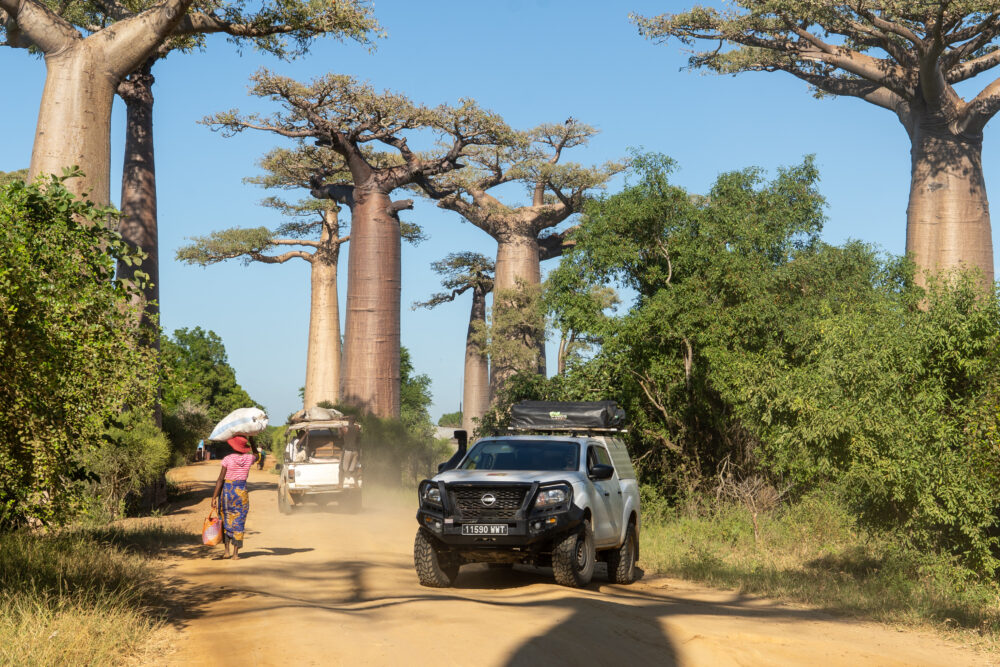
Currently, there is only a 5,000 MGA parking fee for visiting Baobab Avenue.
Where to Stay at Baobab Avenue
While many itineraries suggest you go all the way back to Morondava, there is a better plan. If you’re keen to camp with an incredible view, you can stay in the parking lot area of Baobab Avenue for 40,000 MGA ($8). This way, you can take night photographs of the Baobab and see it at sunrise before all the cars arrive. You also minimize back-tracking by not driving all the way to Morondava.
We also saw a Madame Bertha Lemur in camp here!
Day 18: Baobab Avenue to Miandrivazo
- Real Life Drive Time: 5 hours, 260 KM
- Road Conditions: Follow the pavement of the RN35 to the RN34. Great road, easy to travel.
No need to be in a hurry today. The town of Miandrivazo is nothing to write home about. It’s just a stopover on your way back toward the Tana area.
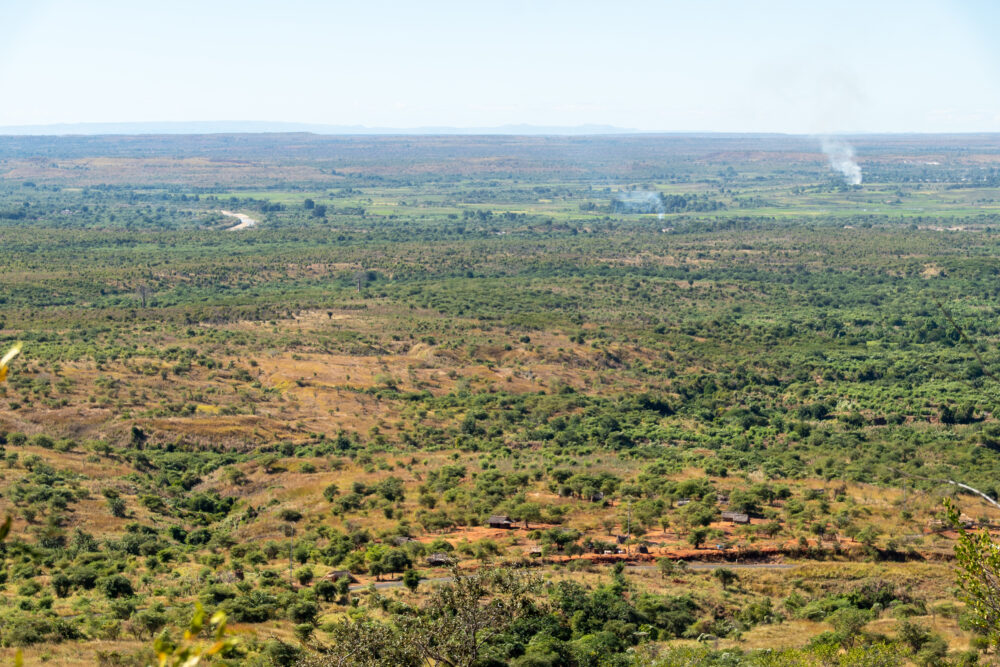
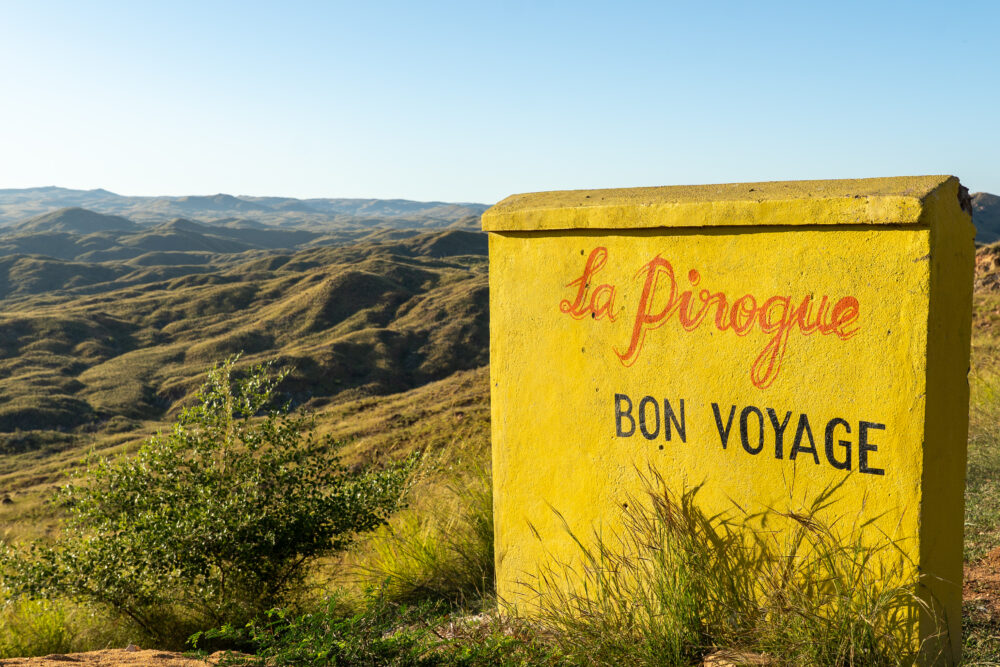
Where to Stay in Miandrivazo
You have three options in Miandrivazo town with varying levels of comfort. If you want to book a comfortable room in advance, I recommend the Soa Lia Hotel. But if you’re willing to be flexible and wait until you arrive, these are the best options…
You can wild camp just outside Miandrivazo (toward Antsirabe) in one of the numerous pull-outs I have marked on Maps.me.
You can pay to camp at La Pirogue in Miandrivazo. They will allow you to stay in their semi-flat camping area if you buy food or beer from their very affordable restaurant.
You can opt for a very comfortable room for $30 with a pool and views at Princesse Tsiribihina.
Day 19: Miandrivazo to Ambatolampy
- Real Life Drive Time: 8 hours, 315 KM
- Road Conditions: The first part of the road outside of Miandrivazo is very pot-holed and crappy. But eventually, it smooths out nicely. The drive today is LONG, so get an early start.
Today, is yet another long transit day on this Madagascar Road Trip.
You *could* pay a visit to Lac Tritriva if you wanted to stretch your legs, but be warned, it costs 50,000 MGA per person to visit the volcanic lake and it’s super super touristy. Our car was swarmed with people selling trinkets when we arrived, and despite the sign indicating 20,000 MGA per person to view the lake, they insisted we had to pay a guide fee to even go look at it. We decided it wasn’t worth the trouble, and many tourists who did make the journey up said the same.
Where to Stay in Ambatolampy
The best option for car camping is La Pineta. Not only is it an excellent restaurant specializing in frog legs and duck breast, but it is also removed from the main road and lets you camp in its lovely garden area. The downside is the noise from all the nesting birds here, but still, it is the best option for dinner and a secure place to stay.
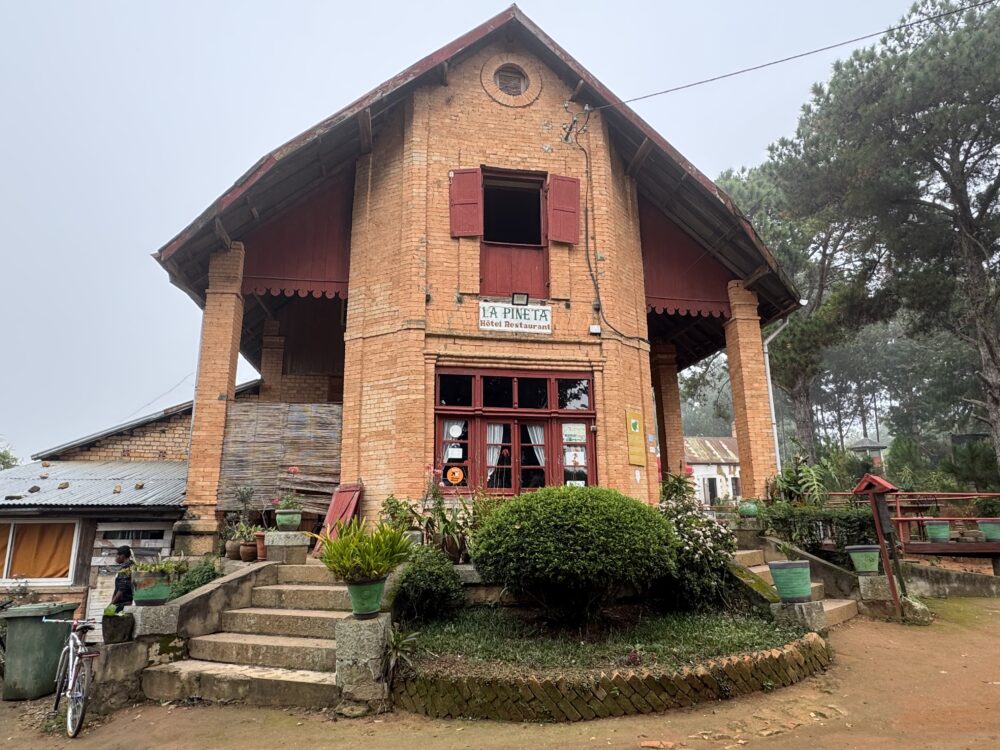
Day 20: Ambatolampy to Andasibe National Park
- Real Life Drive Time: 5-6 hours, 215 KM
- Road Conditions: The sweet, sweet pavement of the RN7 and RN2. At times, the drive can be slow due to trucks (worse on weekends) and winding bends.
It’s the last long drive day of the trip, but Andasibe National Park CANNOT be missed. Make sure that you have enough cash and gas when you pass through Tana on your way toward this final park, as the town surrounding it has few amenities.
Where to Stay in Andasibe
This is your last opportunity to camp, and you 100% should take advantage of it!
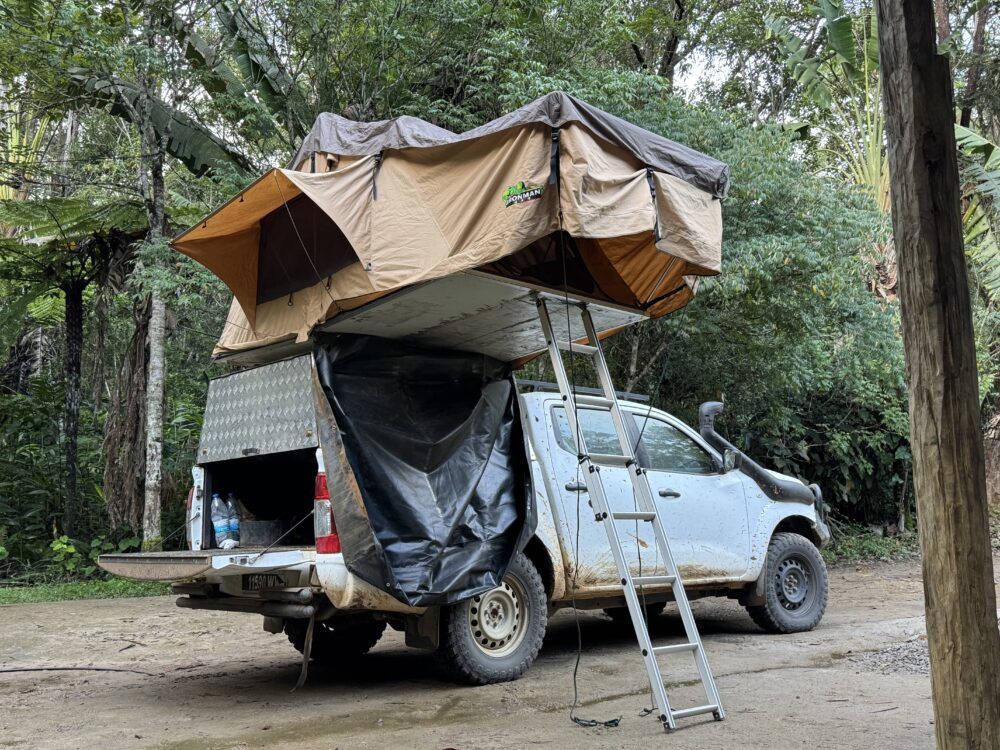
The Mitsinjo Reserve parking lot has one small area for car-camping. It costs only 10,000 MGA per night ($2.50). While in daylight it’s not the most scenic spot, you are immersed in the rainforest and it’s likely you’ll see lemurs and chameleons straight from your campsite at dusk.
Day 21: Andasibe National Park
- Iconic Wildlife to Spot: Indri, Diademed Sifaka, Greater Dwarf Lemur, Goodman’s Mouse Lemur, Eastern Lesser Bamboo Lemur, Ruffed Lemur, and more!
- Must-Do Treks: Mitsinjo Reserve morning trek (2-3 hours), Mitsinjo Reserve night walk
This unique slice of lemur territory is actually split into three distinct parks. Andasibe, Mantadia, and Mitsinjo. I 10,000% recommend that you prioritize Mitsinjo rather than the much more popular Andasibe. Mitsinjo has the best chance of spotting the iconic Indri’s, and it’s where Planet Earth 2 filmed much of its Madagascar footage.
This is the only park, the only place in the world, in fact, where you can hear the weird whale songs of the Indri. These are Madagascar’s largest lemurs and are the most interesting species we spotted. While there are only about 400 of them left in the world, they are heavily featured in Malagasy folklore and are a favorite species by all. Unfortunately, deforestation has decimated their habitat, and this is why their population has shrunk.
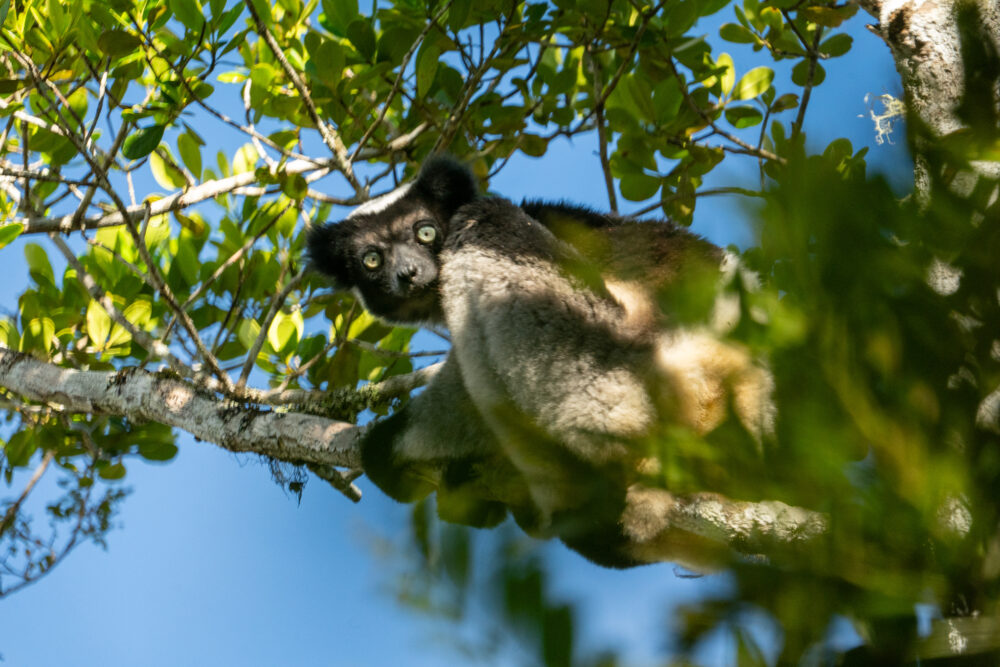
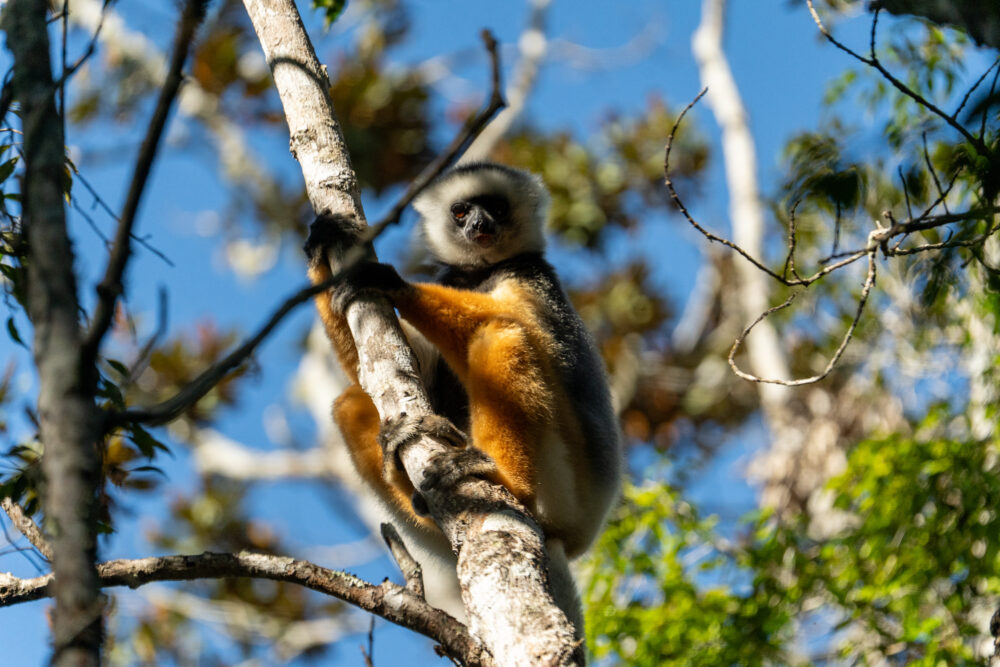
Another unexpected benefit? Mitsinjo is cheaper than Andasibe! The park entrance fee + guide fee for a morning Indri trek is only 60,000 MGA per person. We did the 2-3 hour Louvelli loop.
Night Walks in Andasibe National Park Area
Wondering if you should add a night walk to your Madagascar Road Trip?
This part of the forest is also where the night walk starts, and you have a chance to see the sportive lemurs as well as dwarf lemurs and mouse lemurs alongside Tree Boas, Chameleons, and more. In my personal opinion, this is my favorite of the three night walk destinations.
Quick Andasibe Parks Comparison
Andasibe is popular among less mobile adults as the terrain is meandering and less hilly. Mantadia is for those who have an additional full day to explore grueling trails in primary rainforest (this is what I would like to make time for on a return trip) and search for less commonly spotted species. While Mantadia sounds amazing, the trails are rugged, animal encounters are more fleeting, and any trek takes 8+ hours. If that’s the park you want to visit, you’ll need 2+ days here.
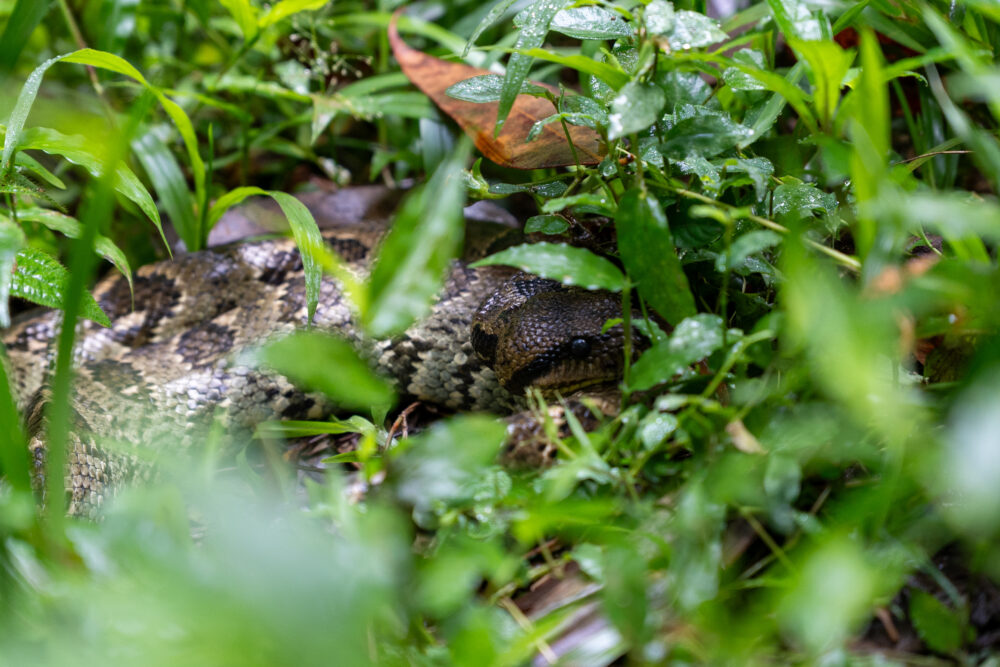

Day 22: Andasibe National Park to Tana (Return Car)
- Real Life Drive Time: 3 hours, 170 KM
- Road Conditions: This route just goes back on the RN2 the same way you came.
Enjoy a slow morning drive back to Tana to return the car!! Today marks the end of your self drive Madagascar Road Trip.
Looking to Make a Few Cuts for Your Madagascar Road Trip?
This is a lengthy trip. If I’m being perfectly honest, it was taxing mentally and physically with all the off-roading, muddy driving, pot-hole navigating, and hiking/exploring crammed in. So if you’re hoping to make some cuts and trim down the itinerary here are my recommendations…
- Andringitra Reserve. There is very little wildlife here. It does, however, have incredible hiking and some of the most impressive scenery in the country. I wouldn’t skip it, but if the off-road is too much of a bother for the views then to each their own.
- Kirindy Reserve. Skip over this reserve if seeing a Fossa is not a MUST on your itinerary. This is the only place you’ll see them, but if that doesn’t bother you, you can get to Tsingy in one day.
- Cut down to one day in Tsingy. This is a psychotic move BUT if you’re desperate to see it all AND save time, you really only need one day in Tsingy. The problem is that it’s a 12-hour drive day to get there and a 12-hour drive day to get back. So you would drive literally all day, hike the next day in the hot sun, and then drive 12 hours again the following day.
- Really looking to make cuts? Check out my 10****Day RN7 Road Trip Itinerary.
Why Flying to Save Time is Risky. Madagascar’s national airline handles all domestic travel in the country, and while it seems well-connected, it is notoriously unreliable when it comes to scheduling. Flights are often delayed or just cancelled altogether at the last minute.
If you’ve made it through this entire Madagascar Road Trip itinerary, you are more than ready to take on Madagascar and its wild roads. Get ready to enjoy the kindness of the Malgasy people, some French wine, idyllic camping, adventurous roads, and incredible flora and fauna all across the island.
Save This Madagascar Road Trip For Later!
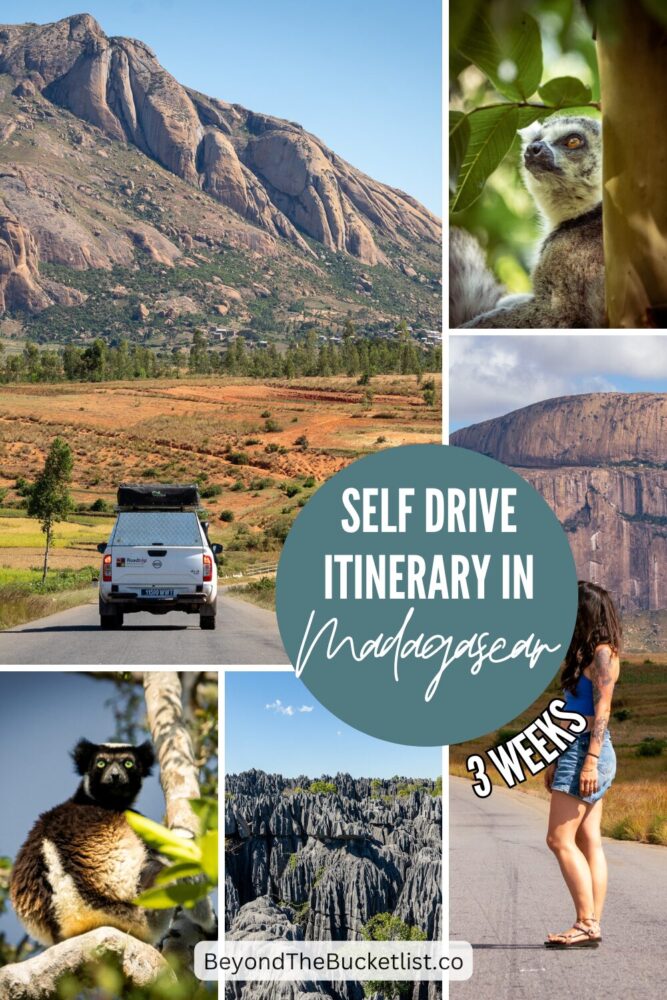
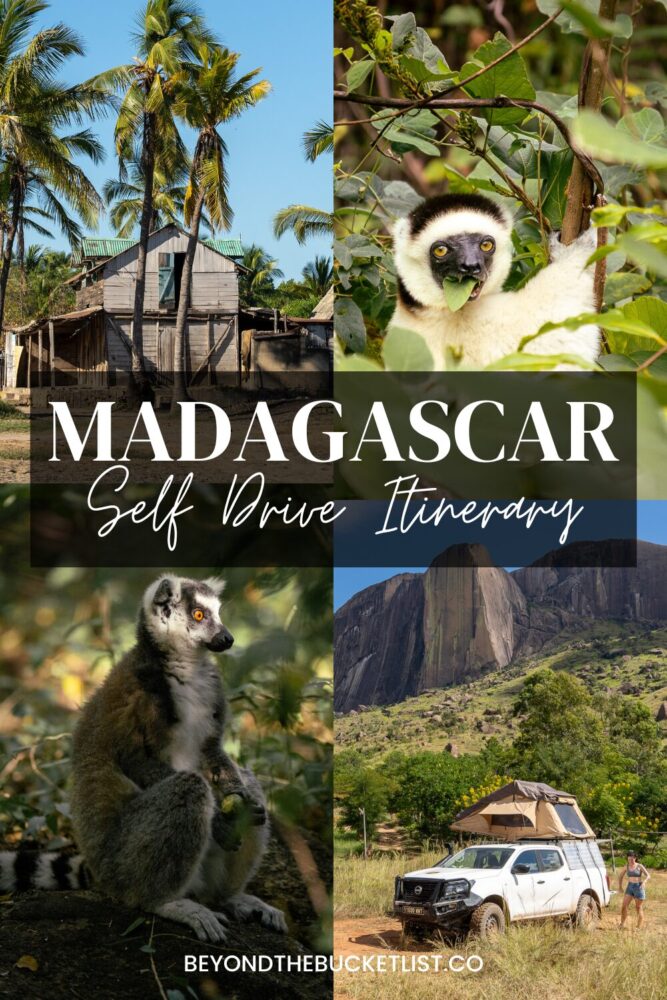


No Comments